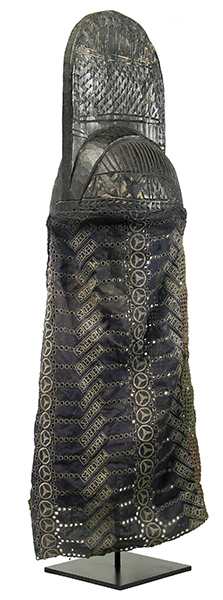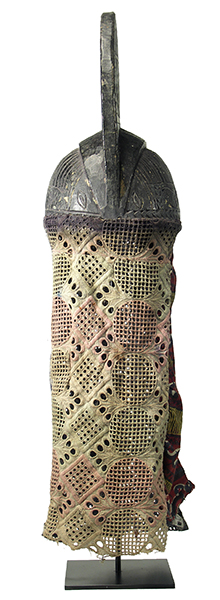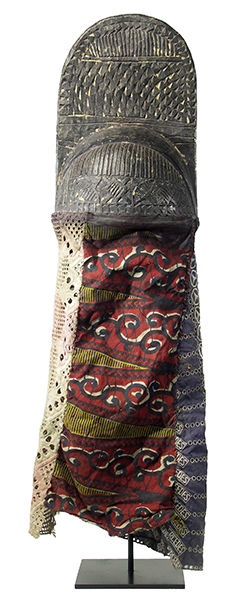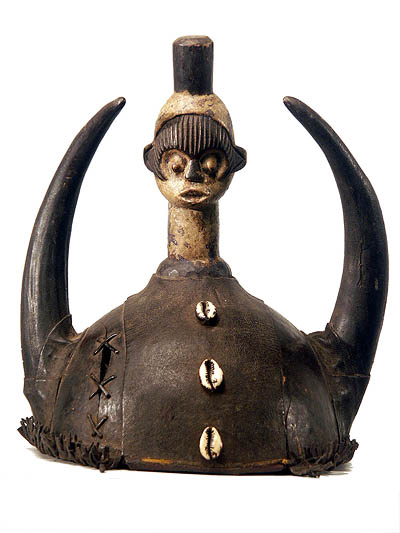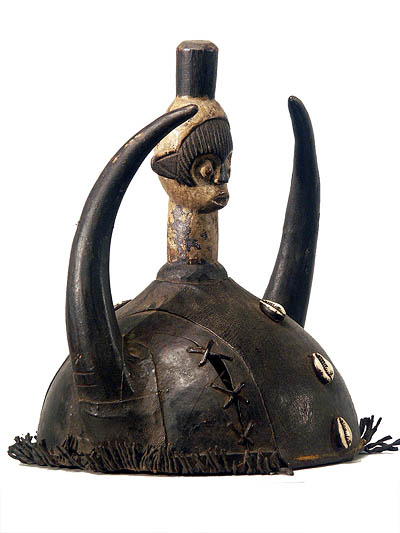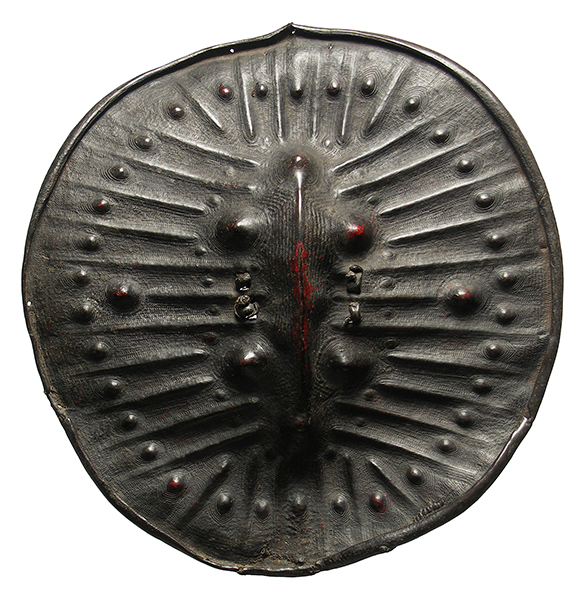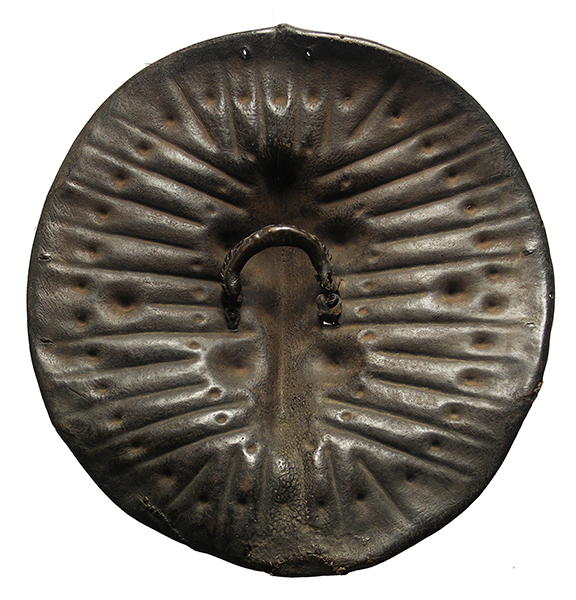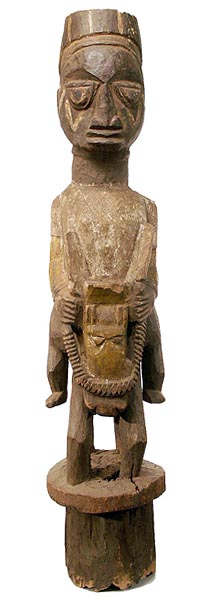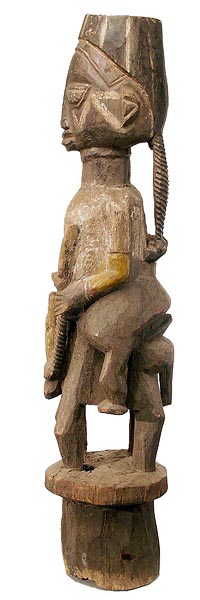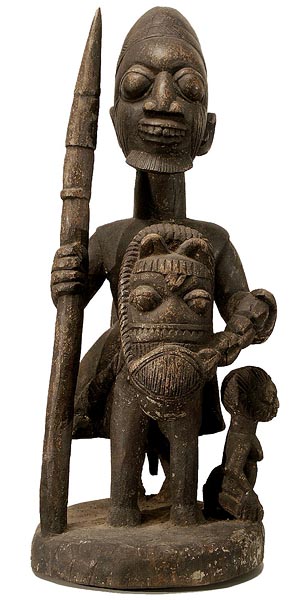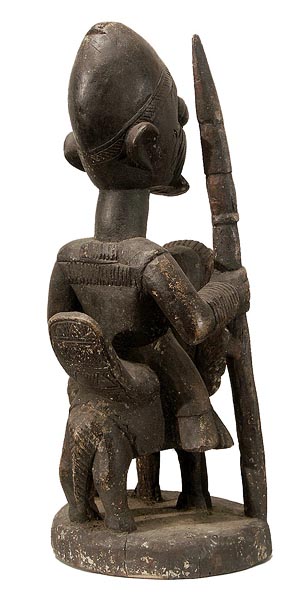Post by anansi on Feb 13, 2012 9:39:47 GMT -5
Truthcentric
Member
Member # 3735
Rate Member posted 23 November, 2011 07:18 PM
Something I wrote earlier this year for a history website:
rtw.heavengames.com/history/civs/ancient_africa/armiesancientafrica/
ARMIES OF ANCIENT AFRICA
Since modern humans (Homo sapiens sapiens) evolved in Africa, that ugly and universal human tradition known as war almost certainly has a longer history on that continent than anywhere else in the world. However, compared with the vast libraries of books about European and Asian warfare, relatively little has been written about African military traditions. Part of the problem is that, since the majority of pre-colonial African societies had no written language, most Africans did not describe their own militaries in writing the way Europeans and Asians did. However, there were exceptions to the rule of African pre-literacy. Some African cultures, such as those of West Africa and Ethiopia, adopted written scripts from Southwest Asians with whom they traded, while others, like the Egyptians and Nubians of the Nile Valley, created their own scripts. We therefore have relatively more knowledge about these civilizations' armies. That said, even those Africans who did not have written languages sometimes had their militaries described by European visitors and settlers, so some information exists about them as well.
Given Africa's cultural diversity, a complete, detailed survey of every African nation's army would require an encyclopedia series, so for the sake of concision, I will focus only on three of the continent's most famous historical cultures: the Egyptians, the Mandinka, and the Zulu.
The Egyptians
In the beginning, the ancient Egyptian army was primitive, at least in comparison with the armies of ancient Europe and Asia. No armor was worn by the common soldier, just the linen loincloth that was standard for Egyptian men. Only a cowhide shield protected him. Since early Egyptians had no knowledge of the horse, they also lacked cavalry. Further handicapping the Egyptians was a relative lack of discipline, since their warriors were usually conscripted commoners rather than trained professionals.
However, the ancient Egyptians did start out with a broad variety of weapons: spears, axes, daggers, clubs, cudgels, and simple bows. Of these, it was the bow that was the Egyptians' favorite weapon (the Nubians to the south were also fond of it, as their land was sometimes called "Land of the Bow"), for Egyptians typically began their attacks by showering their enemies with arrows. Only after these volleys had softened up the enemy would the Egyptian melee infantry charge.
The poor equipment and discipline of the nascent Egyptian army was no problem when fighting other Africans, but once confronted by the more technologically advanced armies of Southwest Asia, the Egyptians were forced to upgrade and reform their military. When the Asian Hyksos took control of the Nile Delta after the Middle Kingdom, they introduced a number of new technologies which the Egyptians would take advantage of once they drove the Hyksos out and began the New Kingdom.
Perhaps the most significant of these new technologies was the horse-driven chariot. However, the Egyptians did not simply adopt this new contraption in its initial form, instead modifying its design so that it was smaller and lighter and therefore more suitable to Egyptian terrain. In New Kingdom armies, chariots were each manned by two men, an archer of noble origin and a driver. If the archer ran out of arrows, he also had spears he could use in close combat. Charioteers were better armored than other Egyptian soldiers, wearing either scale armor or leather bands across the chest.
The New Kingdom also saw a change in military organization. No longer composed of conscripted peasants, the new Egyptian armies were professional in nature. Initiated with a haircut and subjected to rigorous training which included wrestling, knife-throwing, and stick-fighting, the new generation of Egyptian warriors experienced severe discipline in the form of thrashing from fellow recruits.
The New Kingdom militaries each had three to four main divisions, all named after Egyptian gods. There were also two big military corps, one for Egypt's northern provinces and another for its south. In all periods of Egyptian history, the supreme leader of the army was the Pharaoh or one of his relatives.
The Mandinka
The Mandinka of western Africa were the ethnic group responsible for founding the Mali Empire of the 13th to 15th centuries AD. This empire is most often noted for its wealth in gold as well as including Timbuktu, home to the world-famous Sankore University.
The Mandinka's ascension to power followed the collapse of the Ghana Empire in 1076. At this time, a number of small kingdoms such as Sosso, Diafanu, and Jolof filled in the power void left by Ghana. It was against these kingdoms that the early Mandinka fought to expand their territory.
When the Empire began under the Mansa (emperor) Sundjata Keita in the 13th century, the Mandinka army was divided into 16 clans, each led by an archer of noble status known as a ton-tigi ("quiver master"). Each ton-tigi commanded a unit of horsemen, also of elite status, who were armed with lances, sabers, and longswords and wore iron helmets and chain mail. The early Mandinka armies also had foot soldiers commanded by kele-koun ("war heads"); these were mostly bowmen who shot poisoned arrows, although spears and javelins were also used. Providing protection for the infantry were leather helmets and reed shields.
According to the Epic of Sundjata, which describes the Mandinka's defeat of Sosso at the Battle of Krina, Mandinka battle formations had cavalry in the center and infantry on the flanks. At its peak, the Empire's army numbered as much as 100,000 men, with 10,000 of those being horsemen.
After the 13th century, the Mandinka armies underwent reform for reasons not entirely understood. Two new kinds of elite Mandinka warrior arose, the farima ("brave man") and farimba ("great brave man"). Both were known as farari ("braves") and evolved from the ton-tigi commanders of the early empire.
An important member of the Mandinka court, the farima was a military leader and land-owning aristocrat whose main duty was to command cavalry from horseback, though the kele-koun leaders of the infantry also reported to him. In turn, the farima reported to the Mansa, who would reward him with special trousers and gold anklets.
The farimba was also a cavalry commander, but he also served as a provincial governor or deputy. One interesting difference between him and the farima was that while the farima was always a freeman, the farimba sometimes began as a slave. Indeed, it was actually common for Mansas to appoint slaves as farimbas to govern particularly wealthy provinces.
Even those slaves who were not farimbas participated in the Mandinka military during the Mali Empire's later days. Originally restricted to carrying equipment and tending their masters' horses, slaves eventually became full-fledged warriors who made up the majority of the infantry by the 15th century. Slave armies were particularly effective in threatening unfaithful governors.
Another characteristic of the late Mandinka army was its division into two corps, one for the Empire's northern provinces and one for the south, similar to the north-south division of the New Kingdom Egyptian armies. These corps not only conquered for the Empire, but they also protected foreign merchants from bandits.
The Zulu
Unlike the Egyptians, who had their own written language, or the Mandinka, who adopted Arabic for writing, the Zulu remained pre-literate. However, they did have a tradition of oral storytelling which has provided much useful information about their history and military organization.
Before the 19th century, the Zulu were just one of a number of minor Nguni-speaking tribes living in southern Africa. Like other Nguni peoples, the Zulu organized their young men into iNtangas (age groups). Each iNtanga was made up of fifty men and was led by an older man. Most of an iNtanga member’s life was spent guarding cattle, but all the iNtangas in the Zulu tribe also formed its military force. However, there was no formal military training.
Early Zulu fought with javelins and ball-tipped sticks called knobkerries. Like the Egyptians, the Zulu used cowhide for their protective shields, but wore no body armor. In the beginning, Zulu warriors fought independently of each other instead of acting in cohesive formations. War was used to settle quarrels, but not to destroy villages or wipe out other tribes.
Zulu warfare changed significantly with the ascension of Shaka to the Zulu throne in the early 19th century. The illegitimate son of the tribal chief before him, Shaka had a miserable childhood and grew up to be a cruel and genocidal despot who was ultimately assassinated. Though not a man anyone today should venerate as a hero, Shaka can be credited with being an effective military leader and reformer whose conquests raised the Zulu from the status of insignificant tribe to an empire.
One of Shaka's reforms was to introduce the idea of regimentation into Zulu warrior culture. No longer fighting as a chaotic mob of individuals, Zulu warriors were organized into age-based regiments, each with a distinctive headdress or jewelry. Shaka also saw to it that shields were made larger and color-coded, with regiments made of younger soldiers having more black on their shields than those with older members. To make his warriors faster and more sure-footed, Shaka ordered the discarding of traditional sandals and required his men to walk barefoot. Discipline also intensified under Shaka: a disgraced warrior could be executed.
Military tactics also changed under Shaka. Equipping his armies with short, stabbing spears in addition to the traditional javelins and knobkerries, Shaka made heavy use of heavy infantry shock tactics often compared with those of Ancient Greece. Zulu regiments were arranged into a formation shaped like a bull's head: there was a center line with reserves behind it along with two "horns". When a Zulu army in this bull formation attacked, the center line went against the enemy's front while the horns struck the flanks, therefore enveloping the enemy. These tactics were unknown to other tribes in southern Africa, making them vulnerable to Zulu conquest.
At the time of his death, Shaka could muster over 50,000 warriors, but despite these numbers and his new Zulu military's successes against other southern Africans, his Zulu Empire was short-lived thanks to European invaders later in the 19th century. Although the Zulu did win some battles against the British early in the Anglo-Zulu War (Isandhlwana being a famous example), ultimately they lost the War, due in large part to a lack of a clear strategic vision, tactical inflexibility, and a tendency to allow the British too much time to set up fortified strong points.
Comparisons and Contrasts
A common theme shared by Egyptian, Mandinka, and Zulu militaries was the particular importance of ranged weapons for foot soldiers. In Egyptian and Mandinka armies, the bow was preferred for the infantry, while the Zulu prior to Shaka used javelins. This African emphasis on ranged weaponry contrasts heavily with the preference for melee weapons that characterized ancient European warriors such as those of Greece, Rome and Gaul.
Of the three cultures examined here, the Zulu stand out for not making use of the horse, in contrast to Mandinka horsemen and Egyptian chariots (the uneven terrain of the Zulu country was not conducive to cavalry). However, Egyptians prior to the New Kingdom also did not use the horse, so an early Egyptian army would have been on similar footing to a Zulu army. The Egyptians also shared with the Zulu the use of cowhide for shields and a lack of body armor.
With iron chainmail and helmets, the Mandinka had the best armor of our three African militaries, in contrast to the scantily clad Egyptians and Zulu. The heavy importance of horsemen in Mandinka armies would have also given them an advantage even against New Kingdom Egyptian armies, since men directly on horseback can outrun and outmaneuver chariots. In addition, Mandinka archers utilized poison for their arrows, a trick unknown to Egyptian archers and Zulu javelineers. It is because of these advantages that I proclaim the Mandinka to have the strongest army of the three cultures I have surveyed.
Sources
en.wikipedia.org/wiki/Battle_of_Krina
en.wikipedia.org/wiki/Military_history_of_the_Mali_Empire
en.wikipedia.org/wiki/Shaka
www.experience-ancient-egypt.com/ancient-egyptian-soldiers.html
netwar.wordpress.com/2007/07/28/zulu-warfare/
samilitaryhistory.org/vol044sb.html
www.fanaticus.org/DBA/armies/dba120.html
www.reshafim.org.il/ad/egypt/timelines/topics/army.htm
www.reshafim.org.il/ad/egypt/weapons/index.html
www.theancientweb.com/explore/content.aspx?content_id=37
www.touregypt.net/featurestories/chariots.htm
www.touregypt.net/featurestories/soldier.htm
www.touregypt.net/featurestories/weapons.htm
Posts: 2812 | From: California | Registered: Mar 2004 | IP: Logged |
Sundjata
Member
Member # 13096
posted 23 November, 2011 10:02 PM
Decent write up. Some of it strikes me as a bit Eurocentric though.
quote:
In the beginning, the ancient Egyptian army was primitive, at least in comparison with the armies of ancient Europe and Asia.
What do you mean by "primitive"? relative to who around this time (3100 BCE)? What ancient and advanced armies other than Sumer existed in Eurasia "in the beginning" that could have competed with the Egyptians? I personally know of none so I'd have to say this statement is inaccurate.
Also, this reads like a throw back to the Hamitic theory:
quote:
The poor equipment and discipline of the nascent Egyptian army was no problem when fighting other Africans, but once confronted by the more technologically advanced armies of Southwest Asia, the Egyptians were forced to upgrade and reform their military. When the Asian Hyksos took control of the Nile Delta after the Middle Kingdom, they introduced a number of new technologies which the Egyptians would take advantage of once they drove the Hyksos out and began the New Kingdom.
Which "technologically advanced" armies are you referring to? The Egyptians were able to fend off foreign rule, despite numerous invasions for over 2500 years. If that doesn't speak to their technological sophistication I wonder what it says about their strategic discipline. As far as them not having issues with other Africans yet having to upgrade in the face of Eurasian onslaughts, this is curious considering the fact that "other Africans" were able to fend off Eurasians for an even longer period of time, including the Romans who specifically commented on the military sophistication of the Meroites. You don't give the Egyptians enough credit at all.
As for Mandenka I think the importance of the war canoe should also be emphasized. They were actually very influential in guarding the coast and internal river systems. In fact, canoe-bound Mandinka sofas of Niumi were responsible for handing the early Portuguese slave-raiders their earliest defeats and thus forcing them to establish treaties with Africans on equal terms.
BTW, I believe Mandinkas also used flaming arrows (I know the Songhai used them against Djenne during the siege by Sonni Ali).
Good write-up on the Zulu although I take issue with:
quote:
No longer fighting as a chaotic mob of individuals
When has this been the case previously? The cow horn formation existed before Shaka. Shaka only made minor modifications to that strategy. Instilling more discipline doesn't mean that prior to Shaka they were running around like headless chickens throwing spears at each other.
^Just respectful criticism by the way. I commend you for being so actively involved in the proliferation of African history.
Posts: 3953 | From: Bay Area | Registered: Mar 2007 | IP: Logged |
zarahan- aka Enrique Cardova
Member
Member # 15718
posted 23 November, 2011 10:26 PM
This African emphasis on ranged weaponry
contrasts heavily with the preference for melee
weapons that characterized ancient European
warriors such as those of Greece, Rome and
Gaul.
There are some inaccuracies. The 2 definitive articles
on African military on Wiki are called "African
Military Systems" (I wrote most of them so I know).
Check them for more detailed and accurate info.
en.wikipedia.org/wiki/African_military_systems_to_1800
en.wikipedia.org/wiki/African_military_systems_1800-1900
As for the Zulu I can tell you that their use of
ranged weapons, 'javelins', as referred to up above
was minor. THe Zulu used their spears primarily as
a close-in fighting, stabbing weapon. This was the
design reputedly of T'Chaka and while most Zulu
carried one or two throwing spears, their whole
tactical system revolved around close-in fighting.
Ranged weapons were secondary. Other important African militaries
relied mostly on close-in fighting styles, such
as the warrior forces of the Kongo (Angolan region).
Battles opened with throwing of ranged weapons
(just as in Rome), but the decisive blow was struck
by melee type style fighting, hand to hand.
Furthermore the cavalry empires relied heavily on
infantry, who were themselves needed to suppress
the deadly fire of other infantry armed with poisoned arrows. One African pattern that stands
out is the use of "combined arms" - i.e. infantry and
cavalry working in tandem on the battlefield.
It would be more accurate to say that SOME African forces
emphasized ranged weapons, rather than a blanket claim
as to all of Africa.
Furthermore the characterization of Greece, Rome and
Gaul is misleading if made as blanket statements.
The Greeks used the heavy phalanx to be sure, but
always alongside the phalanx were ranged weapons
units. Indeed such units were crucial in helping Alexander defeat non-European cavalry forces.
Rome to be sure used the heavy legion, so the claim is more
accurate, but even Rome relied heavily on ranged
weapons,
not only in opening every battle, but ranged weapons
are one of the keys that helped Rome defeat powerful
opponents cavalry like the Parthians.
the uneven terrain of the Zulu country was not conducive to cavalry).
^^Again not necessarily accurate. Actually the rolling grasslands
of Zululand were very good cavalry country as
proved by the successes of the Boers, who defeated
the Zulu and Zulu-type armies several times, although
in other cases they had some setbacks. Against the
Nedebele, a semi-Zulu offshoot, in similar terrain,
a relatively small group of Boer horsemen kept
out of the range of the charging spearmen whole
pumping volleys of musketry into the African
ranks. The pursuit took several days but always,
the mobility of the horse kept the Boers out of
harms way as they worked over the Nedebele
with their guns. Eventualy, Nedebele commander
Mziklhazi was forced to withdraw.
Other African tribes in SOuth Africa that adopted
horses also saw some success, such as the Basuto, against
both African and European enemies. FOr a good book
on the wars of southern Africa get of Ian Knight's
and Donald Morris' books on the Zulu, but also
get JD Omer-COoper's classic "The Zulu Aftermath"..
a trick unknown to Egyptian archers and Zulu javelineers
^^THe notion of Zulu javeineers is misleading.
It is because of these advantages that I proclaim the Mandinka to have the strongest army of the three cultures I have surveyed.
^^Not necessrily. It could be argued that the
Mandeka would do well primarily in open country
suitable for cavalry, or maneuvering big masses
of infantry. In thick forest country however, they
would be very much less impressive. Indeed the record
shows that when the cavalry forces of some African
empires engaged deep in heavy forest regions their
performance was uneven, and they had their share of defeats.
Sources
^^You are missing 2 big key sources on African
warfare. See African Military Systems on Wiki. If
you work in the info in these 2 articles, I think
you will have stronger essay in the future.
Posts: 2711 | Registered: Aug 2008 | IP: Logged |
Truthcentric
Member
Member # 3735
Rate Member posted 23 November, 2011 10:28 PM
quote:
Originally posted by Sundjata:
What do you mean by "primitive"? relative to who around this time (3100 BCE)? What ancient and advanced armies other than Sumer existed in Eurasia "in the beginning" that could have competed with the Egyptians? I personally know of none so I'd have to say this statement is inaccurate.
The Sumerians were exactly what I had in mind, but you're right, they may not have been representative of all of Southwest Asia, let alone all Eurasia.
quote:
Which "technologically advanced" armies are you referring to? The Egyptians were able to fend off foreign rule, despite numerous invasions for over 2500 years. If that doesn't speak to their technological sophistication I wonder what it says about their strategic discipline.
By "technologically advanced armies", I was referring to people like the Hyksos and Hittites. I don't think there's any dispute that the Egyptians incorporated a lot of Asiatic technology into their military, and that's no more an endorsement of the Hamitic hypothesis than noting the Ashanti and Dahomeans' using firearms introduced from Eurasia. Furthermore, even if the Egyptians did fend off their invaders a few times, they did get conquered in the end (else the great Egyptsearch debate wouldn't be happening).
quote:
As far as them not having issues with other Africans yet having to upgrade in the face of Eurasian onslaughts, this is curious considering the fact that "other Africans" were able to fend off Eurasians for an even longer period of time, including the Romans who specifically commented on the military sophistication of the Meroites. You don't give the Egyptians enough credit at all.
Meoritic Kush was a major upgrade over the Egyptians and Nubians of the third and second millennium BC.
quote:
As for Mandenka I think the importance of the war canoe should also be emphasized. They were actually very influential in guarding the coast and internal river systems. In fact, Mandinka sofas of Niumi were responsible for handing the early Portuguese slave-raiders their earliest defeats and thus forcing them to establish treaties with Africans on equal terms.
BTW, I believe Mandinkas also used flaming arrows (I know the Songhai used them against Djenne during the siege by Sonni Ali).
This is very cool information and I wish my sources had mentioned this.
quote:
When has this been the case previously? The cow horn formation existed before Shaka. Shaka only made minor modifications to that strategy. Instilling more discipline doesn't mean that prior to Shaka they were running around like headless chickens throwing spears at each other.
My sources gave me the impression that pre-Shaka Nguni warriors didn't form cohesive formations (e.g. the cow horn formation) and instead acted as loose groups of individualistic warriors running into each other.
I would be glad to modify my essay in response to your criticisms, but I'm not the RTW Heaven webmaster and since it was posted a long time ago it may be too late to change it.
Posts: 2812 | From: California | Registered: Mar 2004 | IP: Logged |
zarahan- aka Enrique Cardova
Member
Member # 15718
posted 23 November, 2011 10:42 PM
My sources gave me the impression that pre-Shaka Nguni warriors didn't form cohesive formations (e.g. the cow horn formation) and instead acted as loose groups of individualistic warriors running into each other.
^^THe cow-horn, more accurately the "buffalo horns"
formation was known prior to Chaka, but only
primarily as a suprise raid format (such as surrounding
a village at dawn) or sporadically in open field combat.
Under Chaka it was revolutionized into an AGGRESSIVE,
SYSTEMATIC encirclement and envelopment formation
for open field warfare. THis is a lot different
than raiders surrounding the village for the usual
dawn attack, or once on a while maneuvering in
battles prior to Chaka. Chaka also SYsTEMATIZED
movement and standardized units and maneuver.
The younger greener men did most of the running
in the flanking horns, the older veterans were held
in reserve (the loins), and the main blow was
delivered by the prime fighters in the center (the chest).
FIghting units were put on a permanent footing, organized
into regiments, which in turn were organized into
larger corps groupings.
Chaka's innovation was thus systemization and standardization
executed rapidly with deadly aggression. He took
what already existed of course to build on.
Combined with Shaka's "buffalo horns"
attack formation for surrounding and annihilating
enemy forces, the Zulu combination of iklwa and
shield--similar to the Roman legionaries' use of
gladius and scutum--was devastating. By the time
of Shaka's assassination in 1828, it had made
the Zulu kingdom the greatest power in southern
Africa and a force to be reckoned with, even
against Britain's modern army in 1879.[17]
--17) ^ Guttman, Jon. Military History, June 2008, Vol. 24 Issue 4, p. 23
See:
en.wikipedia.org/wiki/African_military_systems_1800-1900
Posts: 2711 | Registered: Aug 2008 | IP: Logged |
Truthcentric
Member
Member # 3735
Rate Member posted 23 November, 2011 10:47 PM
I wish I would have shared my essay with you guys before submitting it to RTW Heaven. You and Sundjata make me look like a newbie to African history!
That said:
quote:
Not necessrily. It could be argued that the
Mandeka would do well primarily in open country
suitable for cavalry, or maneuvering big masses
of infantry. In thick forest country however, they
would be very much less impressive. Indeed the record
shows that when the cavalry forces of some African
empires engaged deep in heavy forest regions their
performance was uneven, and they had their share of defeats.
I should note that I was comparing the Mandinka to two other African cultures that also fought on open terrain. I don't think either Egypt or South Africa are swathed with thick rainforest.
Posts: 2812 | From: California | Registered: Mar 2004 | IP: Logged |
Sundjata
Member
Member # 13096
posted 23 November, 2011 10:48 PM
quote:
My sources gave me the impression that pre-Shaka Nguni warriors didn't form cohesive formations (e.g. the cow horn formation) and instead acted as loose groups of individualistic warriors running into each other.
I would be glad to modify my essay in response to your criticisms, but I'm not the RTW Heaven webmaster and since it was posted a long time ago it may be too late to change it.
^Sorry I don't have a source for this as I distinctly remember discussing this in lecture over the summer ("History of South Africa"). Indeed, my notes suggest that this WAS actually a reform among the Nguni during the Mfecane conflict used by Dingiswayo. It was called "chest-horn" formation and Shaka renamed it to mean "cow-horn".
My source for the information on Niumi sofas comes from reading a few translated texts of portuguese explorers (read about the Mandinka encounters with explorers like Nuno Tristão, Alvise Cadamosto and Diogo Gomes). Al Takuri posted an article specifically addrssing this a while ago as well.
Posts: 3953 | From: Bay Area | Registered: Mar 2007 | IP: Logged |
Sundjata
Member
Member # 13096
posted 23 November, 2011 10:53 PM
quote:
Originally posted by zarahan- aka Enrique Cardova:
My sources gave me the impression that pre-Shaka Nguni warriors didn't form cohesive formations (e.g. the cow horn formation) and instead acted as loose groups of individualistic warriors running into each other.
^^THe cow-horn, more accurately the "buffalo horns"
formation was known prior to Chaka, but only
primarily as a suprise raid format (such as surrounding
a village at dawn) or sporadically in open field combat.
Under Chaka it was revolutionized into an AGGRESSIVE,
SYSTEMATIC encirclement and envelopment formation
for open field warfare. THis is a lot different
than raiders surrounding the village for the usual
dawn attack, or once on a while maneuvering in
battles prior to Chaka. Chaka also SYsTEMATIZED
movement and standardized units and maneuver.
The younger greener men did most of the running
in the flanking horns, the older veterans were held
in reserve (the loins), and the main blow was
delivered by the prime fighters in the center (the chest).
FIghting units were put on a permanent footing, organized
into regiments, which in turn were organized into
larger corps groupings.
Chaka's innovation was thus systemization and standardization
executed rapidly with deadly aggression. He took
what already existed of course to build on.
Combined with Shaka's "buffalo horns"
attack formation for surrounding and annihilating
enemy forces, the Zulu combination of iklwa and
shield--similar to the Roman legionaries' use of
gladius and scutum--was devastating. By the time
of Shaka's assassination in 1828, it had made
the Zulu kingdom the greatest power in southern
Africa and a force to be reckoned with, even
against Britain's modern army in 1879.[17]
--17) ^ Guttman, Jon. Military History, June 2008, Vol. 24 Issue 4, p. 23
See:
en.wikipedia.org/wiki/African_military_systems_1800-1900
Thanks for the clarification.
Posts: 3953 | From: Bay Area | Registered: Mar 2007 | IP: Logged |
zarahan- aka Enrique Cardova
Member
Member # 15718
posted 23 November, 2011 10:59 PM
I should note that I was comparing the Mandinka to two other African cultures that also fought on open terrain. I don't think either Egypt or South Africa are swathed with thick rainforest.
^^Fair enough. As in most "what if" war scenarios,
the possibilities are endless. I would favor the
Mandenka on very large, flat battlefield. However
if a Zulu and Mandenka army met in more varied
terrain, where say, the Zulu could maneuver
in hills and deep ravines the odds are more even,
all other things being equal, because the Zulu could
spring a trap in cut-up or hilly country (still grassland),
or position their forces on top of a hill, and
let Mandinka cavalry attack in disadvantageous
array,
while they maneuvered the horns to cut them off.
Mandinka vs Egyptian? Unknown. ONe thing though-
much African archery south of the Sudan had
weak bow strength and relatively inaccurate arrows.
This was partially offset by poisoned arrows, but
numerous sources note weak bow strength and unfletched
arrows.
One might thus wager, that the Nubians, with their
more powerful bows and better archery, if staying
out of range of the poisoned Mandinka arrows could
chop up the Mandinka infantry and shoot the Mandenka
cavalry horses for an extended period during any
encounter.
The Mandinka of course could close with their cavalry
which would have some tactical advantage against chariots,
but Egyptian and Nubian chariots backed with
Nubian/Egyptian spearmen might/maybe neutralize
a cavalry charge, allowing the Nubian bowmen to
continue their deadly long range killing?
WHo knows? Speculation, but fun.
Posts: 2711 | Registered: Aug 2008 | IP: Logged |
zarahan- aka Enrique Cardova
Member
Member # 15718
posted 23 November, 2011 11:05 PM
Indeed, my notes suggest that this WAS actually a reform among the Nguni during the Mfecane conflict used by Dingiswayo. It was called "chest-horn" formation and Shaka renamed it to mean "cow-horn".
My source for the information on Niumi sofas comes from reading a few translated texts of portuguese explorers (read about the Mandinka encounters with explorers like Nuno Tristão, Alvise Cadamosto and Diogo Gomes). Al Takuri posted an article specifically addrssing this a while ago as well.
^All accurate no doubt. It is good to remind that
Chaka did not get all his innovations out of thin
air. He built on existing elements. Age grade
formations for example were common in the region.
Chaka manipulated and changed them to permanent fighting
formations loyal to him, rather than the traditional clans.
Also DIngswayo was instrumental in forming the larger grouping
and confederation Chaka initially operated in.
SO CHaka is not a sole, superman genius on a hill.
but he a product of his culture. His extremes drew
criticism from Zulu sources it is documented.
Posts: 2711 | Registered: Aug 2008 | IP: Logged |
kenndo
Member
Member # 4846
Rate Member posted 23 November, 2011 11:53 PM
Sofa (warrior)
Sofa is a Mandinka term for slave soldiers who served in the army of the Mali Empire. Sofas would also fight, in varying capacities, in the armies of later Mandé states such as the Bamana and Wassoulou empires.
Etymology
The word sofa translates into English as "father of the horse" ("so" means horse, and "fa" means "father") or "guardian of the horse". This term stems from the original function of the sofa as a caretaker for the horse or horses of Mandinka cavalry commanders called "farari".
Sofa in the Mandinka empire of Mali
Sofas make their first appearance in oral and written records during the formation of the Mali Empire. Sofas were recruited from "jonow" (slaves) captured in battle or bought from afar. They could be depended on in most instances for obedience, since their livelihood depended entirely on their master. The institution of slavery in the Mali Empire heavily rewarded loyalty, and jonow could rise to civil or military positions of prominence. Jonow became part of their master's clan, and were often freed after a certain amount of years. As part of the clan, jonow were expected to accompany their master's into battle and handle his horse and weapons. Initially forbidden from engaging in direct warfare, sofa eventually made up the majority of Mali's infantry army. As infantry, they were armed with bows and arrows by the state or, more accurately, royal clans devoted to the state. In the forest and swampy areas of the Mali Empire, cavalry was minimized or altogether abandoned making sofas the exclusive instrument of war. Sofas were equipped with two quivers, and their bow was small by European standards. It could not fire very far or even powerfully, so sofas utilized deadly poisons and fired in arcs to give the arrows strength. Sofas also used flaming arrows, especially against fortifications that were often little more than thatch or wooden palisades. Some sofas fought as cavalry, at least after being freed, such as Mansa Sakura whom started out his military career as a jonow of the Keita clan. He was freed by Sundjata Keita, became a cavalry commander of some renown and eventually usurped the throne of Mali.
Sofa in the Mané empire of Kquoja
During the 16th century, warriors from the crumbling Mali Empire invaded what is now Sierra Leone and Liberia. This resulted in the establishment of a loose federation of Mané states all paying homage to a single leader in a type of empire called Kquoja by visiting Europeans. The Mané came equipped with the tactics and equipment of the Mali Empire, but were forced to rely almost exclusively on infantry strategies in the jungle terrain. One of the many institutions they brought with them was that of the sofa. Conquered people were conscripted into Mané armies as "sumbas" to strengthen a force that was forever on the move. The sumbas were forced to engage in ritual cannibalism, which permanently alienated them the Mané ruling class. By the end of the 17th century, the Mané had conquered nearly all the indigenous cultures. This resulted in the spread of Mandé language and the end of a single Kquoja authority as the Mané were absorbed into the native landscape.
Posts: 2673 | Registered: Jul 2004 | IP: Logged |
Brada-Anansi
Member
Member # 16371
Rate Member posted 24 November, 2011 02:24 AM
Lets not forget that another southern African folk,The Rowzi of Changamire empire successors to the Mwene Matapa or Zimbabwe,defeated the Portuguese in 1694 also
An interesting four way conflict between the coastal Swahili the Portuguese the Turks and an inland very powerful state called the Malawi empire, who control another people called the Zimba as shock troops..more shocking than most shock troops so because they were reported to be cannibals.
I became aware of the Zimba yrs ago after read one of Dr Clarks books. and I knew they sacked the cities of the coast and eat some of the inhabitance but did not know the reasons why.
Here now is the why they were not some random group of un-controllable barbarians they were in fact a part of the military apparatus of a powerful inland state who could unleashed them at will.
books.google.com/books?id=0K0p8wC....& sig=GfPmEJoSj
www.jstor.org/action/showArticleI....0.2307%2F182189
THE MARAVI EMPIRE
The name Malawi is thought to be a derivation of the word Maravi. The people of the Maravi Empire were iron workers. The name Maravi is thought to mean “rays of light” and may have come from the sight of many kilns lighting up the night sky. A dynasty known as the Maravi Empire was founded by the Amaravi people in the late 15th century. The Amaravi, who eventually became known as the Chewa (a word possibly derived from a term meaning “foreigner”), migrated to Malawi from the region of the modern day Republic of Congo to escape unrest and disease. The Chewa attacked the Akafula, who settled in small family clans without a unified system of protection. Using a system of destruction they would later employ in hunting predatory animals, the Chewa hunted down and butchered the Akufula.
Eventually encompassing most of modern Malawi, as well as parts of modern day Mozambique and Zambia, the Maravi Empire began on the southwestern shores of Lake Malawi. The head of the empire during its expansion was the Kalonga (also spelt Karonga). The Kalonga ruled from his headquarters in Mankhamba. Under the leadership of the Kalonga, sub-chiefs were appointed to occupy and subdue new areas. The empire began to decline during the early 18th century when fighting among the sub-chiefs and the burgeoning slave trade weakened the Maravi Empire’s authority.
Read more: egyptsearchreloaded.proboards.com/index.cgi?board=hist&action=display&thread=394#ixzz1ebprEj3R
Posts: 5568 | From: japan | Registered: Feb 2009 | IP: Logged |
zarahan- aka Enrique Cardova
Member
Member # 15718
posted 24 November, 2011 07:46 AM
Brada, what were these ZImba like militarily? How were
they armed? How did they fight?
Posts: 2711 | Registered: Aug 2008 | IP: Logged |
Djehuti
Member
Member # 6698
Rate Member posted 24 November, 2011 05:18 PM
quote:
Originally posted by Sundjata:
Decent write up. Some of it strikes me as a bit Eurocentric though.
quote:
In the beginning, the ancient Egyptian army was primitive, at least in comparison with the armies of ancient Europe and Asia.
What do you mean by "primitive"? relative to who around this time (3100 BCE)? What ancient and advanced armies other than Sumer existed in Eurasia "in the beginning" that could have competed with the Egyptians? I personally know of none so I'd have to say this statement is inaccurate.
Also, this reads like a throw back to the Hamitic theory:
quote:
The poor equipment and discipline of the nascent Egyptian army was no problem when fighting other Africans, but once confronted by the more technologically advanced armies of Southwest Asia, the Egyptians were forced to upgrade and reform their military. When the Asian Hyksos took control of the Nile Delta after the Middle Kingdom, they introduced a number of new technologies which the Egyptians would take advantage of once they drove the Hyksos out and began the New Kingdom.
Which "technologically advanced" armies are you referring to? The Egyptians were able to fend off foreign rule, despite numerous invasions for over 2500 years. If that doesn't speak to their technological sophistication I wonder what it says about their strategic discipline. As far as them not having issues with other Africans yet having to upgrade in the face of Eurasian onslaughts, this is curious considering the fact that "other Africans" were able to fend off Eurasians for an even longer period of time, including the Romans who specifically commented on the military sophistication of the Meroites. You don't give the Egyptians enough credit at all.
As for Mandenka I think the importance of the war canoe should also be emphasized. They were actually very influential in guarding the coast and internal river systems. In fact, canoe-bound Mandinka sofas of Niumi were responsible for handing the early Portuguese slave-raiders their earliest defeats and thus forcing them to establish treaties with Africans on equal terms.
BTW, I believe Mandinkas also used flaming arrows (I know the Songhai used them against Djenne during the siege by Sonni Ali).
Good write-up on the Zulu although I take issue with:
quote:
No longer fighting as a chaotic mob of individuals
When has this been the case previously? The cow horn formation existed before Shaka. Shaka only made minor modifications to that strategy. Instilling more discipline doesn't mean that prior to Shaka they were running around like headless chickens throwing spears at each other.
^Just respectful criticism by the way. I commend you for being so actively involved in the proliferation of African history.
LOL My thoughts exactly! I too noticed biased language in this essay whether intentional or not. The thing about warfare is that the old saying-- "Necessity is the mother of invention" is quite an understatement. Technological advances as well as military tactics are dependent upon the situations.
Posts: 19377 | From: Atlanta, Georgia, USA | Registered: Feb 2005 | IP: Logged |
Brada-Anansi
Member
Member # 16371
Rate Member posted 24 November, 2011 11:52 PM
Zarahan
quote:
what were these ZImba like militarily? How were they armed? How did they fight?
About how they were organized militarily is hard to say but they might have been similarly armed like their other Ngoni or Bantu neighbors,they were able to sack the Swahili cities on the coast and even some of the nearby Island Kilwa and Zanzibar, they were only stopped by another Ngoni people called the Segeju.
Posts: 5568 | From: japan | Registered: Feb 2009 | IP: Logged |
Djehuti
Member
Member # 6698
Rate Member posted 25 November, 2011 02:13 AM
I would also like to hear more about how so-called "primitive" African armies were able to defeat more "advanced" European armies. I understand this has happened more than once during the European colonization of the continent. The most famous example being the Battle of Isandlwana where Zulus defeated British forces. Obviously such incidences highlight the effectiveness and ingenuity of indigenous African military forces.
Posts: 19377 | From: Atlanta, Georgia, USA | Registered: Feb 2005 | IP: Logged |
Brada-Anansi
Member
Member # 16371
Rate Member posted 25 November, 2011 03:23 AM
I know more of the organizing of the Dahomean Army will post on that later.
Posts: 5568 | From: japan | Registered: Feb 2009 | IP: Logged |
the lioness
Member
Member # 17353
Rate Member posted 26 November, 2011 02:27 PM
quote:
Originally posted by Djehuti:
I would also like to hear more about how so-called "primitive" African armies were able to defeat more "advanced" European armies. I understand this has happened more than once during the European colonization of the continent. The most famous example being the Battle of Isandlwana where Zulus defeated British forces. Obviously such incidences highlight the effectiveness and ingenuity of indigenous African military forces.
Battle of Isandlwana
British forces: 1,800
Zulu: 20,000
Posts: 8479 | Registered: Jan 2010 | IP: Logged |
Djehuti
Member
Member # 6698
Rate Member posted 26 November, 2011 07:36 PM
^ My point exactly!
quote:
Originally posted by the lyinass:
Battle of Isandlwana
British forces: 1,800
Zulu: 20,000
You forgot the part about the British forces being armed with cannons and muskets, while Zulu were armed with only traditional weapons of spears, swords, and bow-and-arrows. Surely mere numbers were not the only reason for the Zulu victory, Lyinass.
One important reason was that the Zulus employed a tactic called the 'bull's horns' onto the British regiments.
Posts: 19377 | From: Atlanta, Georgia, USA | Registered: Feb 2005 | IP: Logged |
zarahan- aka Enrique Cardova
Member
Member # 15718
posted 26 November, 2011 11:24 PM
quote:
Originally posted by Djehuti:
I would also like to hear more about how so-called "primitive" African armies were able to defeat more "advanced" European armies. I understand this has happened more than once during the European colonization of the continent. The most famous example being the Battle of Isandlwana where Zulus defeated British forces. Obviously such incidences highlight the effectiveness and ingenuity of indigenous African military forces.
See the Wiki articles mentioned above:
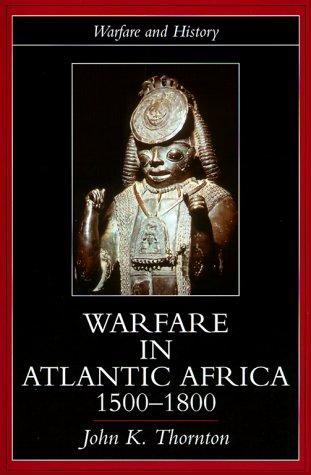
en.wikipedia.org/wiki/African_military_systems_to_1800
en.wikipedia.org/wiki/African_military_systems_1800-1900
Yeap- extensively cited in the 2 above articles.
good book.
Originally posted by Djehuti:
One important reason was that the Zulus employed a tactic called the 'bull's horns' onto the British regiments.
YEap- numbers seldom tell the whole tale. In the
Blitz onf WWII, the combined French and British
armies outnumbered the GErmans substantially on
paper, including more tanks and aircraft. But they lost
to the Wermacht.
The Zulu faced cannon, artillery rockets, rifles
and later in the war machine guns but armed
mostly with spears and shields they outmaneuvered
the British, advancing by stealth to a very good
attack position. And while one half of the British
army was off searching for the so-called Zulu "main army"
the said "main army" materialized behind their backs
to attack the other half of the British forces, left
in the camp at Isandhlwana. THe Zulu killed more
British officers at Isandhlwana, than Napoleon
killed at Waterloo.
Posts: 2711 | Registered: Aug 2008 | IP: Logged |
zarahan- aka Enrique Cardova
Member
Member # 15718
posted 26 November, 2011 11:32 PM
Ethiopian forces inflicted the most casualties
of ANY major battle of the 19th century. Furthermore
they used modern arms effectively, with one of their
artillery batteries, playing a key role in the battle,
outgunning artillery fired by the Italian forces
at a crucial phase.
QUOTE:
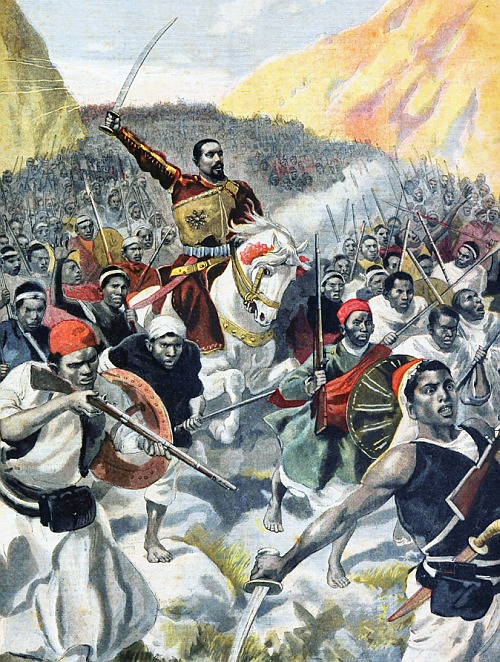
"Baratieri's army suffered 50 percent casualties, far higher
than those suffered by participants in any other major battle of
the nineteenth century. Eylau, the greatest blood-letting of the
Napoleonic era, cost the French army casualties of 33.8 per
cent and its losses at Waterloo were just under 30 per cent.
"Macello, carneficina, strage" (butchery, slaughterhouse,
slaughter) are the words which recur in the memories of the
Italian combatants at Adowa."
--Bruce Vandervort, Wars of Imperial Conquest in Africa:
1830-1914, Indiana University Press: 1998, pp. 39
Posts: 2711 | Registered: Aug 2008 | IP: Logged |
Sundjata
Member
Member # 13096
posted 26 November, 2011 11:56 PM
quote:
Originally posted by Djehuti:
I would also like to hear more about how so-called "primitive" African armies were able to defeat more "advanced" European armies. I understand this has happened more than once during the European colonization of the continent.
Just wrote a term paper on Samori Toure of Guinea. You should look him up. He defeated the French in battle on numerous occasions thanks to the tenacity of his troops and modernization of his army. One thing that he was able to do was capitalize on technology by assigning black smiths the task of manufacturing and repairing European firearms. His cavalry forces also made him extremely mobile in guerrilla warfare. Most importantly he inherited the legacy of Mali and was supported by Mandinka troops who were relentless in the defense of their country (and perhaps religion as most were Islamic). It was because of people like him that it took so long for French colonialists to conquer the Sudan (even though they'd been trying to do so basically since the 1850s and had already set up shop in Morocco and Algeria since the 1830s). Indeed, the French found themselves in a protracted war with Samori for nearly 20 years, which is ridiculous considering that France was THE major world power at the time, outside of Britain.
Posts: 3953 | From: Bay Area | Registered: Mar 2007 | IP: Logged |
zarahan- aka Enrique Cardova
Member
Member # 15718
posted 27 November, 2011 12:06 AM
sun,
can you pass on a link to your term paper? Looks
interesting.
Posts: 2711 | Registered: Aug 2008 | IP: Logged |
Sundjata
Member
Member # 13096
posted 27 November, 2011 12:14 AM
^No problem. Honestly though, the thesis has more to do with the cultural/historical traditions that were rooted in Samori's resistance as opposed to the military organization of his troops (my agenda is clearly stated in the intro).
www.sendspace.com/file/ni0v4z
Posts: 3953 | From: Bay Area | Registered: Mar 2007 | IP: Logged |
Doug M
Member
Member # 7650
Member Rated:
posted 27 November, 2011 10:29 AM
From the old book "Great African Travellers"
Tuareg and Tebu:

Bodyguards of Sultan of Bornu:



Buffalo Hunting:

Begharmi (Baguirmi) Lancers:
Caboseer and his soldiers
Posts: 5761 | Registered: May 2005 | IP: Logged |
alTakruri
Member
Member # 10195
Rate Member posted 27 November, 2011 12:19 PM
quote:
Originally posted by Sundjata:
^No problem. Honestly though, the thesis has more to do with the cultural/historical traditions that were rooted in Samori's resistance as opposed to the military organization of his troops (my agenda is clearly stated in the intro).
www.sendspace.com/file/ni0v4z [/QB]
PDFed your doc with save as PDF in MS Office.
It's a keeper, and then plus some. thx.
Don't choke when you see it being sold to students
Posts: 7871 | From: the Tekrur in the Western Sahel | Registered: Feb 2006 | IP: Logged |
Djehuti
Member
Member # 6698
Rate Member posted 27 November, 2011 06:40 PM
quote:
Originally posted by Sundjata:
^No problem. Honestly though, the thesis has more to do with the cultural/historical traditions that were rooted in Samori's resistance as opposed to the military organization of his troops (my agenda is clearly stated in the intro).
www.sendspace.com/file/ni0v4z
Ditto that! Sundjata, you got a lot of excellent stuff! One thing I admire is the tenacity and endurance of colonized peoples to fight back against their oppressors.
quote:
Originally posted by Sundjata:
Just wrote a term paper on Samori Toure of Guinea. You should look him up. He defeated the French in battle on numerous occasions thanks to the tenacity of his troops and modernization of his army. One thing that he was able to do was capitalize on technology by assigning black smiths the task of manufacturing and repairing European firearms. His cavalry forces also made him extremely mobile in guerrilla warfare. Most importantly he inherited the legacy of Mali and was supported by Mandinka troops who were relentless in the defense of their country (and perhaps religion as most were Islamic). It was because of people like him that it took so long for French colonialists to conquer the Sudan (even though they'd been trying to do so basically since the 1850s and had already set up shop in Morocco and Algeria since the 1830s). Indeed, the French found themselves in a protracted war with Samori for nearly 20 years, which is ridiculous considering that France was THE major world power at the time, outside of Britain.
^ Yes a very interesting guy. A lot people forget that of all the imperialist nations of Europe, France was the most brutal (well them and Belgium)!! People mostly talk about the British, but the British in many instances were more humane in the treatment of native peoples than the French and Belgians!
Posts: 19377 | From: Atlanta, Georgia, USA | Registered: Feb 2005 | IP: Logged |
Brada-Anansi
Member
Member # 16371
Rate Member posted 27 November, 2011 10:37 PM
The use of Wiki here is appropriate for I have the book beside me in case of some one meddling with original.while this book deals mainly with female troops the training was the same for both men and women
The Mino were recruited from among the ahosi ("king's wives") of which there were often hundreds. Some women in Fon society became ahosi voluntarily, while others were involuntarily enrolled if their husbands or fathers complained to the King about their behaviour. Membership among the Mino was supposed to hone any aggressive character traits for the purpose of war. During their membership they were not allowed to have children or be part of married life. Many of them were virgins. The regiment had a semi-sacred status, which was intertwined with the Fon belief in Vodun.
The Mino trained with intense physical exercise. Discipline was emphasised. In the latter period, they were armed with Winchester rifles, clubs and knives. Units were under female command. Captives who fell into the hands of the Amazons were often decapitated.
European encroachment into west Africa gained pace during the latter half of the 19th century, and in 1890 King Behanzin started fighting French forces in the course of the First Franco-Dahomean War. According to Holmes, many of the French soldiers fighting in Dahomey hesitated before shooting or bayoneting the Mino. The resulting delay led to many of the French casualties.
However, according to at least two easily-identifiable sources, the French army lost several battles to them—not because of French "hesitation," but due to the female warriors' skill in battle that was "the equal of every contemporary body of male elite soldiers from among the colonial powers"
Ultimately, bolstered by the Foreign Legion, and armed with superior weaponry, including machine guns, as well as cavalry and Marine infantry, the French inflicted casualties that were ten times worse on the Dahomey side. After several battles, the French prevailed. The Legionnaires later wrote about the "incredible courage and audacity" of the Amazons. The last surviving Amazon of Dahomey died in 1979.
en.wikipedia.org/wiki/Dahomey_Amazons
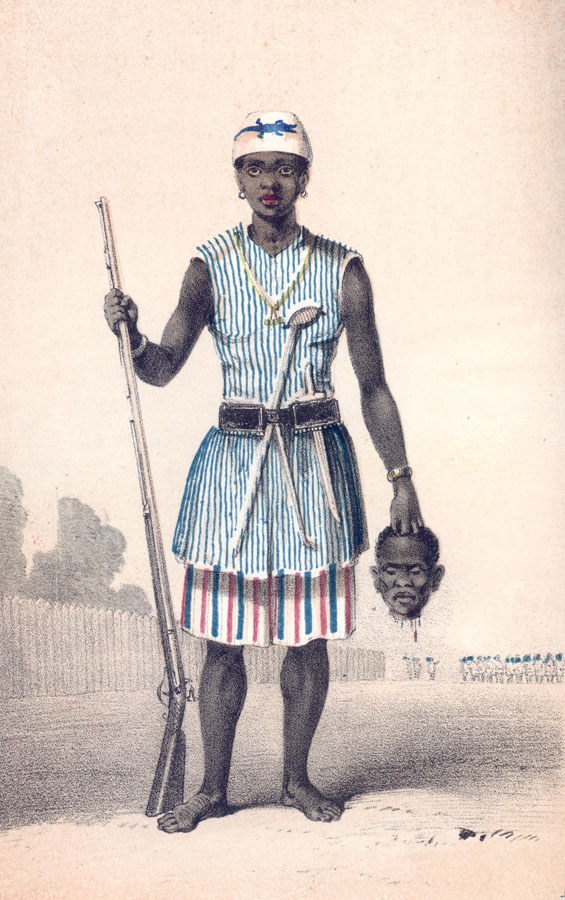
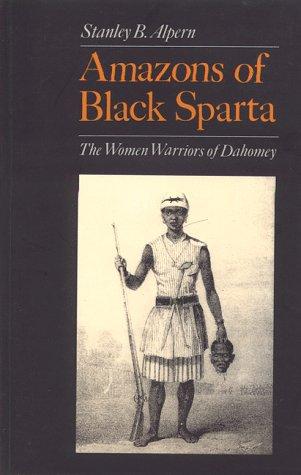
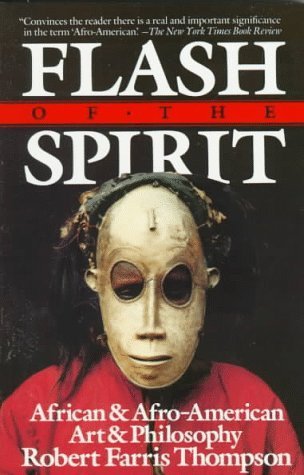
Ladies and Gentlemen two books that is a must have in your collection,can't recommend them enough..
Posts: 5568 | From: japan | Registered: Feb 2009 | IP: Logged |
Sundjata
Member
Member # 13096
posted 28 November, 2011 07:51 AM
^^Thanks Djehuti. While it's another argument entirely, it can even be stated that Samori's efforts wasn't a "resistance" movement as opposed to a clash between two imperial powers (the former almost implies that Samori and his sofas were subjects).
quote:
Originally posted by alTakruri:
quote:
Originally posted by Sundjata:
^No problem. Honestly though, the thesis has more to do with the cultural/historical traditions that were rooted in Samori's resistance as opposed to the military organization of his troops (my agenda is clearly stated in the intro).
www.sendspace.com/file/ni0v4z
PDFed your doc with save as PDF in MS Office.
It's a keeper, and then plus some. thx.
Don't choke when you see it being sold to students [/QB]
LOL.. I probably would choke, only because after re-critiquing I discovered more typos (albeit, minor) that I'd missed in my previous drafts. Oh well..
Thanks, btw.
Posts: 3953 | From: Bay Area | Registered: Mar 2007 | IP: Logged |
Whatbox
Member
Member # 10819
posted 28 November, 2011 02:42 PM
quote:
Originally posted by Brada-Anansi:
Ladies and Gentlemen two books that is a must have in your collection,can't recommend them enough..
Really? I mean for the latter.
Any book having a title with the word "Amazons" and such a pic is at least give-it-a-glance interesting automatically (more than give-it-a-glance, if likely containing historical and not fictional stuff inside).
Posts: 5538 | From: Tha 5th Dimension. | Registered: Apr 2006 | IP: Logged |
Whatbox
Member
Member # 10819
posted 28 November, 2011 03:02 PM
Tyro, first, I'd like to say, good job.
Some of my criticisms and praises ring in different places than the others, so if you will, read on..
quote:
Originally posted by Truthcentric:
ARMIES OF ANCIENT AFRICA
Since modern humans (Homo sapiens sapiens) evolved in Africa, that ugly and universal human tradition known as war almost certainly has a longer history on that continent than anywhere else in the world.
The bolded phrase and terms - modern-human, Homo sapiens sapiens and evolved, respectively - strike me as speech less so common and moreso lingo-ish / jargony, meaning speech very specific to a community -- in this case the scientific and / or nerdy comm
Member
Member # 3735
Rate Member posted 23 November, 2011 07:18 PM
Something I wrote earlier this year for a history website:
rtw.heavengames.com/history/civs/ancient_africa/armiesancientafrica/
ARMIES OF ANCIENT AFRICA
Since modern humans (Homo sapiens sapiens) evolved in Africa, that ugly and universal human tradition known as war almost certainly has a longer history on that continent than anywhere else in the world. However, compared with the vast libraries of books about European and Asian warfare, relatively little has been written about African military traditions. Part of the problem is that, since the majority of pre-colonial African societies had no written language, most Africans did not describe their own militaries in writing the way Europeans and Asians did. However, there were exceptions to the rule of African pre-literacy. Some African cultures, such as those of West Africa and Ethiopia, adopted written scripts from Southwest Asians with whom they traded, while others, like the Egyptians and Nubians of the Nile Valley, created their own scripts. We therefore have relatively more knowledge about these civilizations' armies. That said, even those Africans who did not have written languages sometimes had their militaries described by European visitors and settlers, so some information exists about them as well.
Given Africa's cultural diversity, a complete, detailed survey of every African nation's army would require an encyclopedia series, so for the sake of concision, I will focus only on three of the continent's most famous historical cultures: the Egyptians, the Mandinka, and the Zulu.
The Egyptians
In the beginning, the ancient Egyptian army was primitive, at least in comparison with the armies of ancient Europe and Asia. No armor was worn by the common soldier, just the linen loincloth that was standard for Egyptian men. Only a cowhide shield protected him. Since early Egyptians had no knowledge of the horse, they also lacked cavalry. Further handicapping the Egyptians was a relative lack of discipline, since their warriors were usually conscripted commoners rather than trained professionals.
However, the ancient Egyptians did start out with a broad variety of weapons: spears, axes, daggers, clubs, cudgels, and simple bows. Of these, it was the bow that was the Egyptians' favorite weapon (the Nubians to the south were also fond of it, as their land was sometimes called "Land of the Bow"), for Egyptians typically began their attacks by showering their enemies with arrows. Only after these volleys had softened up the enemy would the Egyptian melee infantry charge.
The poor equipment and discipline of the nascent Egyptian army was no problem when fighting other Africans, but once confronted by the more technologically advanced armies of Southwest Asia, the Egyptians were forced to upgrade and reform their military. When the Asian Hyksos took control of the Nile Delta after the Middle Kingdom, they introduced a number of new technologies which the Egyptians would take advantage of once they drove the Hyksos out and began the New Kingdom.
Perhaps the most significant of these new technologies was the horse-driven chariot. However, the Egyptians did not simply adopt this new contraption in its initial form, instead modifying its design so that it was smaller and lighter and therefore more suitable to Egyptian terrain. In New Kingdom armies, chariots were each manned by two men, an archer of noble origin and a driver. If the archer ran out of arrows, he also had spears he could use in close combat. Charioteers were better armored than other Egyptian soldiers, wearing either scale armor or leather bands across the chest.
The New Kingdom also saw a change in military organization. No longer composed of conscripted peasants, the new Egyptian armies were professional in nature. Initiated with a haircut and subjected to rigorous training which included wrestling, knife-throwing, and stick-fighting, the new generation of Egyptian warriors experienced severe discipline in the form of thrashing from fellow recruits.
The New Kingdom militaries each had three to four main divisions, all named after Egyptian gods. There were also two big military corps, one for Egypt's northern provinces and another for its south. In all periods of Egyptian history, the supreme leader of the army was the Pharaoh or one of his relatives.
The Mandinka
The Mandinka of western Africa were the ethnic group responsible for founding the Mali Empire of the 13th to 15th centuries AD. This empire is most often noted for its wealth in gold as well as including Timbuktu, home to the world-famous Sankore University.
The Mandinka's ascension to power followed the collapse of the Ghana Empire in 1076. At this time, a number of small kingdoms such as Sosso, Diafanu, and Jolof filled in the power void left by Ghana. It was against these kingdoms that the early Mandinka fought to expand their territory.
When the Empire began under the Mansa (emperor) Sundjata Keita in the 13th century, the Mandinka army was divided into 16 clans, each led by an archer of noble status known as a ton-tigi ("quiver master"). Each ton-tigi commanded a unit of horsemen, also of elite status, who were armed with lances, sabers, and longswords and wore iron helmets and chain mail. The early Mandinka armies also had foot soldiers commanded by kele-koun ("war heads"); these were mostly bowmen who shot poisoned arrows, although spears and javelins were also used. Providing protection for the infantry were leather helmets and reed shields.
According to the Epic of Sundjata, which describes the Mandinka's defeat of Sosso at the Battle of Krina, Mandinka battle formations had cavalry in the center and infantry on the flanks. At its peak, the Empire's army numbered as much as 100,000 men, with 10,000 of those being horsemen.
After the 13th century, the Mandinka armies underwent reform for reasons not entirely understood. Two new kinds of elite Mandinka warrior arose, the farima ("brave man") and farimba ("great brave man"). Both were known as farari ("braves") and evolved from the ton-tigi commanders of the early empire.
An important member of the Mandinka court, the farima was a military leader and land-owning aristocrat whose main duty was to command cavalry from horseback, though the kele-koun leaders of the infantry also reported to him. In turn, the farima reported to the Mansa, who would reward him with special trousers and gold anklets.
The farimba was also a cavalry commander, but he also served as a provincial governor or deputy. One interesting difference between him and the farima was that while the farima was always a freeman, the farimba sometimes began as a slave. Indeed, it was actually common for Mansas to appoint slaves as farimbas to govern particularly wealthy provinces.
Even those slaves who were not farimbas participated in the Mandinka military during the Mali Empire's later days. Originally restricted to carrying equipment and tending their masters' horses, slaves eventually became full-fledged warriors who made up the majority of the infantry by the 15th century. Slave armies were particularly effective in threatening unfaithful governors.
Another characteristic of the late Mandinka army was its division into two corps, one for the Empire's northern provinces and one for the south, similar to the north-south division of the New Kingdom Egyptian armies. These corps not only conquered for the Empire, but they also protected foreign merchants from bandits.
The Zulu
Unlike the Egyptians, who had their own written language, or the Mandinka, who adopted Arabic for writing, the Zulu remained pre-literate. However, they did have a tradition of oral storytelling which has provided much useful information about their history and military organization.
Before the 19th century, the Zulu were just one of a number of minor Nguni-speaking tribes living in southern Africa. Like other Nguni peoples, the Zulu organized their young men into iNtangas (age groups). Each iNtanga was made up of fifty men and was led by an older man. Most of an iNtanga member’s life was spent guarding cattle, but all the iNtangas in the Zulu tribe also formed its military force. However, there was no formal military training.
Early Zulu fought with javelins and ball-tipped sticks called knobkerries. Like the Egyptians, the Zulu used cowhide for their protective shields, but wore no body armor. In the beginning, Zulu warriors fought independently of each other instead of acting in cohesive formations. War was used to settle quarrels, but not to destroy villages or wipe out other tribes.
Zulu warfare changed significantly with the ascension of Shaka to the Zulu throne in the early 19th century. The illegitimate son of the tribal chief before him, Shaka had a miserable childhood and grew up to be a cruel and genocidal despot who was ultimately assassinated. Though not a man anyone today should venerate as a hero, Shaka can be credited with being an effective military leader and reformer whose conquests raised the Zulu from the status of insignificant tribe to an empire.
One of Shaka's reforms was to introduce the idea of regimentation into Zulu warrior culture. No longer fighting as a chaotic mob of individuals, Zulu warriors were organized into age-based regiments, each with a distinctive headdress or jewelry. Shaka also saw to it that shields were made larger and color-coded, with regiments made of younger soldiers having more black on their shields than those with older members. To make his warriors faster and more sure-footed, Shaka ordered the discarding of traditional sandals and required his men to walk barefoot. Discipline also intensified under Shaka: a disgraced warrior could be executed.
Military tactics also changed under Shaka. Equipping his armies with short, stabbing spears in addition to the traditional javelins and knobkerries, Shaka made heavy use of heavy infantry shock tactics often compared with those of Ancient Greece. Zulu regiments were arranged into a formation shaped like a bull's head: there was a center line with reserves behind it along with two "horns". When a Zulu army in this bull formation attacked, the center line went against the enemy's front while the horns struck the flanks, therefore enveloping the enemy. These tactics were unknown to other tribes in southern Africa, making them vulnerable to Zulu conquest.
At the time of his death, Shaka could muster over 50,000 warriors, but despite these numbers and his new Zulu military's successes against other southern Africans, his Zulu Empire was short-lived thanks to European invaders later in the 19th century. Although the Zulu did win some battles against the British early in the Anglo-Zulu War (Isandhlwana being a famous example), ultimately they lost the War, due in large part to a lack of a clear strategic vision, tactical inflexibility, and a tendency to allow the British too much time to set up fortified strong points.
Comparisons and Contrasts
A common theme shared by Egyptian, Mandinka, and Zulu militaries was the particular importance of ranged weapons for foot soldiers. In Egyptian and Mandinka armies, the bow was preferred for the infantry, while the Zulu prior to Shaka used javelins. This African emphasis on ranged weaponry contrasts heavily with the preference for melee weapons that characterized ancient European warriors such as those of Greece, Rome and Gaul.
Of the three cultures examined here, the Zulu stand out for not making use of the horse, in contrast to Mandinka horsemen and Egyptian chariots (the uneven terrain of the Zulu country was not conducive to cavalry). However, Egyptians prior to the New Kingdom also did not use the horse, so an early Egyptian army would have been on similar footing to a Zulu army. The Egyptians also shared with the Zulu the use of cowhide for shields and a lack of body armor.
With iron chainmail and helmets, the Mandinka had the best armor of our three African militaries, in contrast to the scantily clad Egyptians and Zulu. The heavy importance of horsemen in Mandinka armies would have also given them an advantage even against New Kingdom Egyptian armies, since men directly on horseback can outrun and outmaneuver chariots. In addition, Mandinka archers utilized poison for their arrows, a trick unknown to Egyptian archers and Zulu javelineers. It is because of these advantages that I proclaim the Mandinka to have the strongest army of the three cultures I have surveyed.
Sources
en.wikipedia.org/wiki/Battle_of_Krina
en.wikipedia.org/wiki/Military_history_of_the_Mali_Empire
en.wikipedia.org/wiki/Shaka
www.experience-ancient-egypt.com/ancient-egyptian-soldiers.html
netwar.wordpress.com/2007/07/28/zulu-warfare/
samilitaryhistory.org/vol044sb.html
www.fanaticus.org/DBA/armies/dba120.html
www.reshafim.org.il/ad/egypt/timelines/topics/army.htm
www.reshafim.org.il/ad/egypt/weapons/index.html
www.theancientweb.com/explore/content.aspx?content_id=37
www.touregypt.net/featurestories/chariots.htm
www.touregypt.net/featurestories/soldier.htm
www.touregypt.net/featurestories/weapons.htm
Posts: 2812 | From: California | Registered: Mar 2004 | IP: Logged |
Sundjata
Member
Member # 13096
posted 23 November, 2011 10:02 PM
Decent write up. Some of it strikes me as a bit Eurocentric though.
quote:
In the beginning, the ancient Egyptian army was primitive, at least in comparison with the armies of ancient Europe and Asia.
What do you mean by "primitive"? relative to who around this time (3100 BCE)? What ancient and advanced armies other than Sumer existed in Eurasia "in the beginning" that could have competed with the Egyptians? I personally know of none so I'd have to say this statement is inaccurate.
Also, this reads like a throw back to the Hamitic theory:
quote:
The poor equipment and discipline of the nascent Egyptian army was no problem when fighting other Africans, but once confronted by the more technologically advanced armies of Southwest Asia, the Egyptians were forced to upgrade and reform their military. When the Asian Hyksos took control of the Nile Delta after the Middle Kingdom, they introduced a number of new technologies which the Egyptians would take advantage of once they drove the Hyksos out and began the New Kingdom.
Which "technologically advanced" armies are you referring to? The Egyptians were able to fend off foreign rule, despite numerous invasions for over 2500 years. If that doesn't speak to their technological sophistication I wonder what it says about their strategic discipline. As far as them not having issues with other Africans yet having to upgrade in the face of Eurasian onslaughts, this is curious considering the fact that "other Africans" were able to fend off Eurasians for an even longer period of time, including the Romans who specifically commented on the military sophistication of the Meroites. You don't give the Egyptians enough credit at all.
As for Mandenka I think the importance of the war canoe should also be emphasized. They were actually very influential in guarding the coast and internal river systems. In fact, canoe-bound Mandinka sofas of Niumi were responsible for handing the early Portuguese slave-raiders their earliest defeats and thus forcing them to establish treaties with Africans on equal terms.
BTW, I believe Mandinkas also used flaming arrows (I know the Songhai used them against Djenne during the siege by Sonni Ali).
Good write-up on the Zulu although I take issue with:
quote:
No longer fighting as a chaotic mob of individuals
When has this been the case previously? The cow horn formation existed before Shaka. Shaka only made minor modifications to that strategy. Instilling more discipline doesn't mean that prior to Shaka they were running around like headless chickens throwing spears at each other.
^Just respectful criticism by the way. I commend you for being so actively involved in the proliferation of African history.
Posts: 3953 | From: Bay Area | Registered: Mar 2007 | IP: Logged |
zarahan- aka Enrique Cardova
Member
Member # 15718
posted 23 November, 2011 10:26 PM
This African emphasis on ranged weaponry
contrasts heavily with the preference for melee
weapons that characterized ancient European
warriors such as those of Greece, Rome and
Gaul.
There are some inaccuracies. The 2 definitive articles
on African military on Wiki are called "African
Military Systems" (I wrote most of them so I know).
Check them for more detailed and accurate info.
en.wikipedia.org/wiki/African_military_systems_to_1800
en.wikipedia.org/wiki/African_military_systems_1800-1900
As for the Zulu I can tell you that their use of
ranged weapons, 'javelins', as referred to up above
was minor. THe Zulu used their spears primarily as
a close-in fighting, stabbing weapon. This was the
design reputedly of T'Chaka and while most Zulu
carried one or two throwing spears, their whole
tactical system revolved around close-in fighting.
Ranged weapons were secondary. Other important African militaries
relied mostly on close-in fighting styles, such
as the warrior forces of the Kongo (Angolan region).
Battles opened with throwing of ranged weapons
(just as in Rome), but the decisive blow was struck
by melee type style fighting, hand to hand.
Furthermore the cavalry empires relied heavily on
infantry, who were themselves needed to suppress
the deadly fire of other infantry armed with poisoned arrows. One African pattern that stands
out is the use of "combined arms" - i.e. infantry and
cavalry working in tandem on the battlefield.
It would be more accurate to say that SOME African forces
emphasized ranged weapons, rather than a blanket claim
as to all of Africa.
Furthermore the characterization of Greece, Rome and
Gaul is misleading if made as blanket statements.
The Greeks used the heavy phalanx to be sure, but
always alongside the phalanx were ranged weapons
units. Indeed such units were crucial in helping Alexander defeat non-European cavalry forces.
Rome to be sure used the heavy legion, so the claim is more
accurate, but even Rome relied heavily on ranged
weapons,
not only in opening every battle, but ranged weapons
are one of the keys that helped Rome defeat powerful
opponents cavalry like the Parthians.
the uneven terrain of the Zulu country was not conducive to cavalry).
^^Again not necessarily accurate. Actually the rolling grasslands
of Zululand were very good cavalry country as
proved by the successes of the Boers, who defeated
the Zulu and Zulu-type armies several times, although
in other cases they had some setbacks. Against the
Nedebele, a semi-Zulu offshoot, in similar terrain,
a relatively small group of Boer horsemen kept
out of the range of the charging spearmen whole
pumping volleys of musketry into the African
ranks. The pursuit took several days but always,
the mobility of the horse kept the Boers out of
harms way as they worked over the Nedebele
with their guns. Eventualy, Nedebele commander
Mziklhazi was forced to withdraw.
Other African tribes in SOuth Africa that adopted
horses also saw some success, such as the Basuto, against
both African and European enemies. FOr a good book
on the wars of southern Africa get of Ian Knight's
and Donald Morris' books on the Zulu, but also
get JD Omer-COoper's classic "The Zulu Aftermath"..
a trick unknown to Egyptian archers and Zulu javelineers
^^THe notion of Zulu javeineers is misleading.
It is because of these advantages that I proclaim the Mandinka to have the strongest army of the three cultures I have surveyed.
^^Not necessrily. It could be argued that the
Mandeka would do well primarily in open country
suitable for cavalry, or maneuvering big masses
of infantry. In thick forest country however, they
would be very much less impressive. Indeed the record
shows that when the cavalry forces of some African
empires engaged deep in heavy forest regions their
performance was uneven, and they had their share of defeats.
Sources
^^You are missing 2 big key sources on African
warfare. See African Military Systems on Wiki. If
you work in the info in these 2 articles, I think
you will have stronger essay in the future.
Posts: 2711 | Registered: Aug 2008 | IP: Logged |
Truthcentric
Member
Member # 3735
Rate Member posted 23 November, 2011 10:28 PM
quote:
Originally posted by Sundjata:
What do you mean by "primitive"? relative to who around this time (3100 BCE)? What ancient and advanced armies other than Sumer existed in Eurasia "in the beginning" that could have competed with the Egyptians? I personally know of none so I'd have to say this statement is inaccurate.
The Sumerians were exactly what I had in mind, but you're right, they may not have been representative of all of Southwest Asia, let alone all Eurasia.
quote:
Which "technologically advanced" armies are you referring to? The Egyptians were able to fend off foreign rule, despite numerous invasions for over 2500 years. If that doesn't speak to their technological sophistication I wonder what it says about their strategic discipline.
By "technologically advanced armies", I was referring to people like the Hyksos and Hittites. I don't think there's any dispute that the Egyptians incorporated a lot of Asiatic technology into their military, and that's no more an endorsement of the Hamitic hypothesis than noting the Ashanti and Dahomeans' using firearms introduced from Eurasia. Furthermore, even if the Egyptians did fend off their invaders a few times, they did get conquered in the end (else the great Egyptsearch debate wouldn't be happening).
quote:
As far as them not having issues with other Africans yet having to upgrade in the face of Eurasian onslaughts, this is curious considering the fact that "other Africans" were able to fend off Eurasians for an even longer period of time, including the Romans who specifically commented on the military sophistication of the Meroites. You don't give the Egyptians enough credit at all.
Meoritic Kush was a major upgrade over the Egyptians and Nubians of the third and second millennium BC.
quote:
As for Mandenka I think the importance of the war canoe should also be emphasized. They were actually very influential in guarding the coast and internal river systems. In fact, Mandinka sofas of Niumi were responsible for handing the early Portuguese slave-raiders their earliest defeats and thus forcing them to establish treaties with Africans on equal terms.
BTW, I believe Mandinkas also used flaming arrows (I know the Songhai used them against Djenne during the siege by Sonni Ali).
This is very cool information and I wish my sources had mentioned this.
quote:
When has this been the case previously? The cow horn formation existed before Shaka. Shaka only made minor modifications to that strategy. Instilling more discipline doesn't mean that prior to Shaka they were running around like headless chickens throwing spears at each other.
My sources gave me the impression that pre-Shaka Nguni warriors didn't form cohesive formations (e.g. the cow horn formation) and instead acted as loose groups of individualistic warriors running into each other.
I would be glad to modify my essay in response to your criticisms, but I'm not the RTW Heaven webmaster and since it was posted a long time ago it may be too late to change it.
Posts: 2812 | From: California | Registered: Mar 2004 | IP: Logged |
zarahan- aka Enrique Cardova
Member
Member # 15718
posted 23 November, 2011 10:42 PM
My sources gave me the impression that pre-Shaka Nguni warriors didn't form cohesive formations (e.g. the cow horn formation) and instead acted as loose groups of individualistic warriors running into each other.
^^THe cow-horn, more accurately the "buffalo horns"
formation was known prior to Chaka, but only
primarily as a suprise raid format (such as surrounding
a village at dawn) or sporadically in open field combat.
Under Chaka it was revolutionized into an AGGRESSIVE,
SYSTEMATIC encirclement and envelopment formation
for open field warfare. THis is a lot different
than raiders surrounding the village for the usual
dawn attack, or once on a while maneuvering in
battles prior to Chaka. Chaka also SYsTEMATIZED
movement and standardized units and maneuver.
The younger greener men did most of the running
in the flanking horns, the older veterans were held
in reserve (the loins), and the main blow was
delivered by the prime fighters in the center (the chest).
FIghting units were put on a permanent footing, organized
into regiments, which in turn were organized into
larger corps groupings.
Chaka's innovation was thus systemization and standardization
executed rapidly with deadly aggression. He took
what already existed of course to build on.
Combined with Shaka's "buffalo horns"
attack formation for surrounding and annihilating
enemy forces, the Zulu combination of iklwa and
shield--similar to the Roman legionaries' use of
gladius and scutum--was devastating. By the time
of Shaka's assassination in 1828, it had made
the Zulu kingdom the greatest power in southern
Africa and a force to be reckoned with, even
against Britain's modern army in 1879.[17]
--17) ^ Guttman, Jon. Military History, June 2008, Vol. 24 Issue 4, p. 23
See:
en.wikipedia.org/wiki/African_military_systems_1800-1900
Posts: 2711 | Registered: Aug 2008 | IP: Logged |
Truthcentric
Member
Member # 3735
Rate Member posted 23 November, 2011 10:47 PM
I wish I would have shared my essay with you guys before submitting it to RTW Heaven. You and Sundjata make me look like a newbie to African history!
That said:
quote:
Not necessrily. It could be argued that the
Mandeka would do well primarily in open country
suitable for cavalry, or maneuvering big masses
of infantry. In thick forest country however, they
would be very much less impressive. Indeed the record
shows that when the cavalry forces of some African
empires engaged deep in heavy forest regions their
performance was uneven, and they had their share of defeats.
I should note that I was comparing the Mandinka to two other African cultures that also fought on open terrain. I don't think either Egypt or South Africa are swathed with thick rainforest.
Posts: 2812 | From: California | Registered: Mar 2004 | IP: Logged |
Sundjata
Member
Member # 13096
posted 23 November, 2011 10:48 PM
quote:
My sources gave me the impression that pre-Shaka Nguni warriors didn't form cohesive formations (e.g. the cow horn formation) and instead acted as loose groups of individualistic warriors running into each other.
I would be glad to modify my essay in response to your criticisms, but I'm not the RTW Heaven webmaster and since it was posted a long time ago it may be too late to change it.
^Sorry I don't have a source for this as I distinctly remember discussing this in lecture over the summer ("History of South Africa"). Indeed, my notes suggest that this WAS actually a reform among the Nguni during the Mfecane conflict used by Dingiswayo. It was called "chest-horn" formation and Shaka renamed it to mean "cow-horn".
My source for the information on Niumi sofas comes from reading a few translated texts of portuguese explorers (read about the Mandinka encounters with explorers like Nuno Tristão, Alvise Cadamosto and Diogo Gomes). Al Takuri posted an article specifically addrssing this a while ago as well.
Posts: 3953 | From: Bay Area | Registered: Mar 2007 | IP: Logged |
Sundjata
Member
Member # 13096
posted 23 November, 2011 10:53 PM
quote:
Originally posted by zarahan- aka Enrique Cardova:
My sources gave me the impression that pre-Shaka Nguni warriors didn't form cohesive formations (e.g. the cow horn formation) and instead acted as loose groups of individualistic warriors running into each other.
^^THe cow-horn, more accurately the "buffalo horns"
formation was known prior to Chaka, but only
primarily as a suprise raid format (such as surrounding
a village at dawn) or sporadically in open field combat.
Under Chaka it was revolutionized into an AGGRESSIVE,
SYSTEMATIC encirclement and envelopment formation
for open field warfare. THis is a lot different
than raiders surrounding the village for the usual
dawn attack, or once on a while maneuvering in
battles prior to Chaka. Chaka also SYsTEMATIZED
movement and standardized units and maneuver.
The younger greener men did most of the running
in the flanking horns, the older veterans were held
in reserve (the loins), and the main blow was
delivered by the prime fighters in the center (the chest).
FIghting units were put on a permanent footing, organized
into regiments, which in turn were organized into
larger corps groupings.
Chaka's innovation was thus systemization and standardization
executed rapidly with deadly aggression. He took
what already existed of course to build on.
Combined with Shaka's "buffalo horns"
attack formation for surrounding and annihilating
enemy forces, the Zulu combination of iklwa and
shield--similar to the Roman legionaries' use of
gladius and scutum--was devastating. By the time
of Shaka's assassination in 1828, it had made
the Zulu kingdom the greatest power in southern
Africa and a force to be reckoned with, even
against Britain's modern army in 1879.[17]
--17) ^ Guttman, Jon. Military History, June 2008, Vol. 24 Issue 4, p. 23
See:
en.wikipedia.org/wiki/African_military_systems_1800-1900
Thanks for the clarification.
Posts: 3953 | From: Bay Area | Registered: Mar 2007 | IP: Logged |
zarahan- aka Enrique Cardova
Member
Member # 15718
posted 23 November, 2011 10:59 PM
I should note that I was comparing the Mandinka to two other African cultures that also fought on open terrain. I don't think either Egypt or South Africa are swathed with thick rainforest.
^^Fair enough. As in most "what if" war scenarios,
the possibilities are endless. I would favor the
Mandenka on very large, flat battlefield. However
if a Zulu and Mandenka army met in more varied
terrain, where say, the Zulu could maneuver
in hills and deep ravines the odds are more even,
all other things being equal, because the Zulu could
spring a trap in cut-up or hilly country (still grassland),
or position their forces on top of a hill, and
let Mandinka cavalry attack in disadvantageous
array,
while they maneuvered the horns to cut them off.
Mandinka vs Egyptian? Unknown. ONe thing though-
much African archery south of the Sudan had
weak bow strength and relatively inaccurate arrows.
This was partially offset by poisoned arrows, but
numerous sources note weak bow strength and unfletched
arrows.
One might thus wager, that the Nubians, with their
more powerful bows and better archery, if staying
out of range of the poisoned Mandinka arrows could
chop up the Mandinka infantry and shoot the Mandenka
cavalry horses for an extended period during any
encounter.
The Mandinka of course could close with their cavalry
which would have some tactical advantage against chariots,
but Egyptian and Nubian chariots backed with
Nubian/Egyptian spearmen might/maybe neutralize
a cavalry charge, allowing the Nubian bowmen to
continue their deadly long range killing?
WHo knows? Speculation, but fun.
Posts: 2711 | Registered: Aug 2008 | IP: Logged |
zarahan- aka Enrique Cardova
Member
Member # 15718
posted 23 November, 2011 11:05 PM
Indeed, my notes suggest that this WAS actually a reform among the Nguni during the Mfecane conflict used by Dingiswayo. It was called "chest-horn" formation and Shaka renamed it to mean "cow-horn".
My source for the information on Niumi sofas comes from reading a few translated texts of portuguese explorers (read about the Mandinka encounters with explorers like Nuno Tristão, Alvise Cadamosto and Diogo Gomes). Al Takuri posted an article specifically addrssing this a while ago as well.
^All accurate no doubt. It is good to remind that
Chaka did not get all his innovations out of thin
air. He built on existing elements. Age grade
formations for example were common in the region.
Chaka manipulated and changed them to permanent fighting
formations loyal to him, rather than the traditional clans.
Also DIngswayo was instrumental in forming the larger grouping
and confederation Chaka initially operated in.
SO CHaka is not a sole, superman genius on a hill.
but he a product of his culture. His extremes drew
criticism from Zulu sources it is documented.
Posts: 2711 | Registered: Aug 2008 | IP: Logged |
kenndo
Member
Member # 4846
Rate Member posted 23 November, 2011 11:53 PM
Sofa (warrior)
Sofa is a Mandinka term for slave soldiers who served in the army of the Mali Empire. Sofas would also fight, in varying capacities, in the armies of later Mandé states such as the Bamana and Wassoulou empires.
Etymology
The word sofa translates into English as "father of the horse" ("so" means horse, and "fa" means "father") or "guardian of the horse". This term stems from the original function of the sofa as a caretaker for the horse or horses of Mandinka cavalry commanders called "farari".
Sofa in the Mandinka empire of Mali
Sofas make their first appearance in oral and written records during the formation of the Mali Empire. Sofas were recruited from "jonow" (slaves) captured in battle or bought from afar. They could be depended on in most instances for obedience, since their livelihood depended entirely on their master. The institution of slavery in the Mali Empire heavily rewarded loyalty, and jonow could rise to civil or military positions of prominence. Jonow became part of their master's clan, and were often freed after a certain amount of years. As part of the clan, jonow were expected to accompany their master's into battle and handle his horse and weapons. Initially forbidden from engaging in direct warfare, sofa eventually made up the majority of Mali's infantry army. As infantry, they were armed with bows and arrows by the state or, more accurately, royal clans devoted to the state. In the forest and swampy areas of the Mali Empire, cavalry was minimized or altogether abandoned making sofas the exclusive instrument of war. Sofas were equipped with two quivers, and their bow was small by European standards. It could not fire very far or even powerfully, so sofas utilized deadly poisons and fired in arcs to give the arrows strength. Sofas also used flaming arrows, especially against fortifications that were often little more than thatch or wooden palisades. Some sofas fought as cavalry, at least after being freed, such as Mansa Sakura whom started out his military career as a jonow of the Keita clan. He was freed by Sundjata Keita, became a cavalry commander of some renown and eventually usurped the throne of Mali.
Sofa in the Mané empire of Kquoja
During the 16th century, warriors from the crumbling Mali Empire invaded what is now Sierra Leone and Liberia. This resulted in the establishment of a loose federation of Mané states all paying homage to a single leader in a type of empire called Kquoja by visiting Europeans. The Mané came equipped with the tactics and equipment of the Mali Empire, but were forced to rely almost exclusively on infantry strategies in the jungle terrain. One of the many institutions they brought with them was that of the sofa. Conquered people were conscripted into Mané armies as "sumbas" to strengthen a force that was forever on the move. The sumbas were forced to engage in ritual cannibalism, which permanently alienated them the Mané ruling class. By the end of the 17th century, the Mané had conquered nearly all the indigenous cultures. This resulted in the spread of Mandé language and the end of a single Kquoja authority as the Mané were absorbed into the native landscape.
Posts: 2673 | Registered: Jul 2004 | IP: Logged |
Brada-Anansi
Member
Member # 16371
Rate Member posted 24 November, 2011 02:24 AM
Lets not forget that another southern African folk,The Rowzi of Changamire empire successors to the Mwene Matapa or Zimbabwe,defeated the Portuguese in 1694 also
An interesting four way conflict between the coastal Swahili the Portuguese the Turks and an inland very powerful state called the Malawi empire, who control another people called the Zimba as shock troops..more shocking than most shock troops so because they were reported to be cannibals.
I became aware of the Zimba yrs ago after read one of Dr Clarks books. and I knew they sacked the cities of the coast and eat some of the inhabitance but did not know the reasons why.
Here now is the why they were not some random group of un-controllable barbarians they were in fact a part of the military apparatus of a powerful inland state who could unleashed them at will.
books.google.com/books?id=0K0p8wC....& sig=GfPmEJoSj
www.jstor.org/action/showArticleI....0.2307%2F182189
THE MARAVI EMPIRE
The name Malawi is thought to be a derivation of the word Maravi. The people of the Maravi Empire were iron workers. The name Maravi is thought to mean “rays of light” and may have come from the sight of many kilns lighting up the night sky. A dynasty known as the Maravi Empire was founded by the Amaravi people in the late 15th century. The Amaravi, who eventually became known as the Chewa (a word possibly derived from a term meaning “foreigner”), migrated to Malawi from the region of the modern day Republic of Congo to escape unrest and disease. The Chewa attacked the Akafula, who settled in small family clans without a unified system of protection. Using a system of destruction they would later employ in hunting predatory animals, the Chewa hunted down and butchered the Akufula.
Eventually encompassing most of modern Malawi, as well as parts of modern day Mozambique and Zambia, the Maravi Empire began on the southwestern shores of Lake Malawi. The head of the empire during its expansion was the Kalonga (also spelt Karonga). The Kalonga ruled from his headquarters in Mankhamba. Under the leadership of the Kalonga, sub-chiefs were appointed to occupy and subdue new areas. The empire began to decline during the early 18th century when fighting among the sub-chiefs and the burgeoning slave trade weakened the Maravi Empire’s authority.
Read more: egyptsearchreloaded.proboards.com/index.cgi?board=hist&action=display&thread=394#ixzz1ebprEj3R
Posts: 5568 | From: japan | Registered: Feb 2009 | IP: Logged |
zarahan- aka Enrique Cardova
Member
Member # 15718
posted 24 November, 2011 07:46 AM
Brada, what were these ZImba like militarily? How were
they armed? How did they fight?
Posts: 2711 | Registered: Aug 2008 | IP: Logged |
Djehuti
Member
Member # 6698
Rate Member posted 24 November, 2011 05:18 PM
quote:
Originally posted by Sundjata:
Decent write up. Some of it strikes me as a bit Eurocentric though.
quote:
In the beginning, the ancient Egyptian army was primitive, at least in comparison with the armies of ancient Europe and Asia.
What do you mean by "primitive"? relative to who around this time (3100 BCE)? What ancient and advanced armies other than Sumer existed in Eurasia "in the beginning" that could have competed with the Egyptians? I personally know of none so I'd have to say this statement is inaccurate.
Also, this reads like a throw back to the Hamitic theory:
quote:
The poor equipment and discipline of the nascent Egyptian army was no problem when fighting other Africans, but once confronted by the more technologically advanced armies of Southwest Asia, the Egyptians were forced to upgrade and reform their military. When the Asian Hyksos took control of the Nile Delta after the Middle Kingdom, they introduced a number of new technologies which the Egyptians would take advantage of once they drove the Hyksos out and began the New Kingdom.
Which "technologically advanced" armies are you referring to? The Egyptians were able to fend off foreign rule, despite numerous invasions for over 2500 years. If that doesn't speak to their technological sophistication I wonder what it says about their strategic discipline. As far as them not having issues with other Africans yet having to upgrade in the face of Eurasian onslaughts, this is curious considering the fact that "other Africans" were able to fend off Eurasians for an even longer period of time, including the Romans who specifically commented on the military sophistication of the Meroites. You don't give the Egyptians enough credit at all.
As for Mandenka I think the importance of the war canoe should also be emphasized. They were actually very influential in guarding the coast and internal river systems. In fact, canoe-bound Mandinka sofas of Niumi were responsible for handing the early Portuguese slave-raiders their earliest defeats and thus forcing them to establish treaties with Africans on equal terms.
BTW, I believe Mandinkas also used flaming arrows (I know the Songhai used them against Djenne during the siege by Sonni Ali).
Good write-up on the Zulu although I take issue with:
quote:
No longer fighting as a chaotic mob of individuals
When has this been the case previously? The cow horn formation existed before Shaka. Shaka only made minor modifications to that strategy. Instilling more discipline doesn't mean that prior to Shaka they were running around like headless chickens throwing spears at each other.
^Just respectful criticism by the way. I commend you for being so actively involved in the proliferation of African history.
LOL My thoughts exactly! I too noticed biased language in this essay whether intentional or not. The thing about warfare is that the old saying-- "Necessity is the mother of invention" is quite an understatement. Technological advances as well as military tactics are dependent upon the situations.
Posts: 19377 | From: Atlanta, Georgia, USA | Registered: Feb 2005 | IP: Logged |
Brada-Anansi
Member
Member # 16371
Rate Member posted 24 November, 2011 11:52 PM
Zarahan
quote:
what were these ZImba like militarily? How were they armed? How did they fight?
About how they were organized militarily is hard to say but they might have been similarly armed like their other Ngoni or Bantu neighbors,they were able to sack the Swahili cities on the coast and even some of the nearby Island Kilwa and Zanzibar, they were only stopped by another Ngoni people called the Segeju.
Posts: 5568 | From: japan | Registered: Feb 2009 | IP: Logged |
Djehuti
Member
Member # 6698
Rate Member posted 25 November, 2011 02:13 AM
I would also like to hear more about how so-called "primitive" African armies were able to defeat more "advanced" European armies. I understand this has happened more than once during the European colonization of the continent. The most famous example being the Battle of Isandlwana where Zulus defeated British forces. Obviously such incidences highlight the effectiveness and ingenuity of indigenous African military forces.
Posts: 19377 | From: Atlanta, Georgia, USA | Registered: Feb 2005 | IP: Logged |
Brada-Anansi
Member
Member # 16371
Rate Member posted 25 November, 2011 03:23 AM
I know more of the organizing of the Dahomean Army will post on that later.
Posts: 5568 | From: japan | Registered: Feb 2009 | IP: Logged |
the lioness
Member
Member # 17353
Rate Member posted 26 November, 2011 02:27 PM
quote:
Originally posted by Djehuti:
I would also like to hear more about how so-called "primitive" African armies were able to defeat more "advanced" European armies. I understand this has happened more than once during the European colonization of the continent. The most famous example being the Battle of Isandlwana where Zulus defeated British forces. Obviously such incidences highlight the effectiveness and ingenuity of indigenous African military forces.
Battle of Isandlwana
British forces: 1,800
Zulu: 20,000
Posts: 8479 | Registered: Jan 2010 | IP: Logged |
Djehuti
Member
Member # 6698
Rate Member posted 26 November, 2011 07:36 PM
^ My point exactly!
quote:
Originally posted by the lyinass:
Battle of Isandlwana
British forces: 1,800
Zulu: 20,000
You forgot the part about the British forces being armed with cannons and muskets, while Zulu were armed with only traditional weapons of spears, swords, and bow-and-arrows. Surely mere numbers were not the only reason for the Zulu victory, Lyinass.
One important reason was that the Zulus employed a tactic called the 'bull's horns' onto the British regiments.
Posts: 19377 | From: Atlanta, Georgia, USA | Registered: Feb 2005 | IP: Logged |
zarahan- aka Enrique Cardova
Member
Member # 15718
posted 26 November, 2011 11:24 PM
quote:
Originally posted by Djehuti:
I would also like to hear more about how so-called "primitive" African armies were able to defeat more "advanced" European armies. I understand this has happened more than once during the European colonization of the continent. The most famous example being the Battle of Isandlwana where Zulus defeated British forces. Obviously such incidences highlight the effectiveness and ingenuity of indigenous African military forces.
See the Wiki articles mentioned above:

en.wikipedia.org/wiki/African_military_systems_to_1800
en.wikipedia.org/wiki/African_military_systems_1800-1900
Yeap- extensively cited in the 2 above articles.
good book.
Originally posted by Djehuti:
One important reason was that the Zulus employed a tactic called the 'bull's horns' onto the British regiments.
YEap- numbers seldom tell the whole tale. In the
Blitz onf WWII, the combined French and British
armies outnumbered the GErmans substantially on
paper, including more tanks and aircraft. But they lost
to the Wermacht.
The Zulu faced cannon, artillery rockets, rifles
and later in the war machine guns but armed
mostly with spears and shields they outmaneuvered
the British, advancing by stealth to a very good
attack position. And while one half of the British
army was off searching for the so-called Zulu "main army"
the said "main army" materialized behind their backs
to attack the other half of the British forces, left
in the camp at Isandhlwana. THe Zulu killed more
British officers at Isandhlwana, than Napoleon
killed at Waterloo.
Posts: 2711 | Registered: Aug 2008 | IP: Logged |
zarahan- aka Enrique Cardova
Member
Member # 15718
posted 26 November, 2011 11:32 PM
Ethiopian forces inflicted the most casualties
of ANY major battle of the 19th century. Furthermore
they used modern arms effectively, with one of their
artillery batteries, playing a key role in the battle,
outgunning artillery fired by the Italian forces
at a crucial phase.
QUOTE:

"Baratieri's army suffered 50 percent casualties, far higher
than those suffered by participants in any other major battle of
the nineteenth century. Eylau, the greatest blood-letting of the
Napoleonic era, cost the French army casualties of 33.8 per
cent and its losses at Waterloo were just under 30 per cent.
"Macello, carneficina, strage" (butchery, slaughterhouse,
slaughter) are the words which recur in the memories of the
Italian combatants at Adowa."
--Bruce Vandervort, Wars of Imperial Conquest in Africa:
1830-1914, Indiana University Press: 1998, pp. 39
Posts: 2711 | Registered: Aug 2008 | IP: Logged |
Sundjata
Member
Member # 13096
posted 26 November, 2011 11:56 PM
quote:
Originally posted by Djehuti:
I would also like to hear more about how so-called "primitive" African armies were able to defeat more "advanced" European armies. I understand this has happened more than once during the European colonization of the continent.
Just wrote a term paper on Samori Toure of Guinea. You should look him up. He defeated the French in battle on numerous occasions thanks to the tenacity of his troops and modernization of his army. One thing that he was able to do was capitalize on technology by assigning black smiths the task of manufacturing and repairing European firearms. His cavalry forces also made him extremely mobile in guerrilla warfare. Most importantly he inherited the legacy of Mali and was supported by Mandinka troops who were relentless in the defense of their country (and perhaps religion as most were Islamic). It was because of people like him that it took so long for French colonialists to conquer the Sudan (even though they'd been trying to do so basically since the 1850s and had already set up shop in Morocco and Algeria since the 1830s). Indeed, the French found themselves in a protracted war with Samori for nearly 20 years, which is ridiculous considering that France was THE major world power at the time, outside of Britain.
Posts: 3953 | From: Bay Area | Registered: Mar 2007 | IP: Logged |
zarahan- aka Enrique Cardova
Member
Member # 15718
posted 27 November, 2011 12:06 AM
sun,
can you pass on a link to your term paper? Looks
interesting.
Posts: 2711 | Registered: Aug 2008 | IP: Logged |
Sundjata
Member
Member # 13096
posted 27 November, 2011 12:14 AM
^No problem. Honestly though, the thesis has more to do with the cultural/historical traditions that were rooted in Samori's resistance as opposed to the military organization of his troops (my agenda is clearly stated in the intro).
www.sendspace.com/file/ni0v4z
Posts: 3953 | From: Bay Area | Registered: Mar 2007 | IP: Logged |
Doug M
Member
Member # 7650
Member Rated:
posted 27 November, 2011 10:29 AM
From the old book "Great African Travellers"
Tuareg and Tebu:
Bodyguards of Sultan of Bornu:
Buffalo Hunting:
Begharmi (Baguirmi) Lancers:
Caboseer and his soldiers
Posts: 5761 | Registered: May 2005 | IP: Logged |
alTakruri
Member
Member # 10195
Rate Member posted 27 November, 2011 12:19 PM
quote:
Originally posted by Sundjata:
^No problem. Honestly though, the thesis has more to do with the cultural/historical traditions that were rooted in Samori's resistance as opposed to the military organization of his troops (my agenda is clearly stated in the intro).
www.sendspace.com/file/ni0v4z [/QB]
PDFed your doc with save as PDF in MS Office.
It's a keeper, and then plus some. thx.
Don't choke when you see it being sold to students
Posts: 7871 | From: the Tekrur in the Western Sahel | Registered: Feb 2006 | IP: Logged |
Djehuti
Member
Member # 6698
Rate Member posted 27 November, 2011 06:40 PM
quote:
Originally posted by Sundjata:
^No problem. Honestly though, the thesis has more to do with the cultural/historical traditions that were rooted in Samori's resistance as opposed to the military organization of his troops (my agenda is clearly stated in the intro).
www.sendspace.com/file/ni0v4z
Ditto that! Sundjata, you got a lot of excellent stuff! One thing I admire is the tenacity and endurance of colonized peoples to fight back against their oppressors.
quote:
Originally posted by Sundjata:
Just wrote a term paper on Samori Toure of Guinea. You should look him up. He defeated the French in battle on numerous occasions thanks to the tenacity of his troops and modernization of his army. One thing that he was able to do was capitalize on technology by assigning black smiths the task of manufacturing and repairing European firearms. His cavalry forces also made him extremely mobile in guerrilla warfare. Most importantly he inherited the legacy of Mali and was supported by Mandinka troops who were relentless in the defense of their country (and perhaps religion as most were Islamic). It was because of people like him that it took so long for French colonialists to conquer the Sudan (even though they'd been trying to do so basically since the 1850s and had already set up shop in Morocco and Algeria since the 1830s). Indeed, the French found themselves in a protracted war with Samori for nearly 20 years, which is ridiculous considering that France was THE major world power at the time, outside of Britain.
^ Yes a very interesting guy. A lot people forget that of all the imperialist nations of Europe, France was the most brutal (well them and Belgium)!! People mostly talk about the British, but the British in many instances were more humane in the treatment of native peoples than the French and Belgians!
Posts: 19377 | From: Atlanta, Georgia, USA | Registered: Feb 2005 | IP: Logged |
Brada-Anansi
Member
Member # 16371
Rate Member posted 27 November, 2011 10:37 PM
The use of Wiki here is appropriate for I have the book beside me in case of some one meddling with original.while this book deals mainly with female troops the training was the same for both men and women
The Mino were recruited from among the ahosi ("king's wives") of which there were often hundreds. Some women in Fon society became ahosi voluntarily, while others were involuntarily enrolled if their husbands or fathers complained to the King about their behaviour. Membership among the Mino was supposed to hone any aggressive character traits for the purpose of war. During their membership they were not allowed to have children or be part of married life. Many of them were virgins. The regiment had a semi-sacred status, which was intertwined with the Fon belief in Vodun.
The Mino trained with intense physical exercise. Discipline was emphasised. In the latter period, they were armed with Winchester rifles, clubs and knives. Units were under female command. Captives who fell into the hands of the Amazons were often decapitated.
European encroachment into west Africa gained pace during the latter half of the 19th century, and in 1890 King Behanzin started fighting French forces in the course of the First Franco-Dahomean War. According to Holmes, many of the French soldiers fighting in Dahomey hesitated before shooting or bayoneting the Mino. The resulting delay led to many of the French casualties.
However, according to at least two easily-identifiable sources, the French army lost several battles to them—not because of French "hesitation," but due to the female warriors' skill in battle that was "the equal of every contemporary body of male elite soldiers from among the colonial powers"
Ultimately, bolstered by the Foreign Legion, and armed with superior weaponry, including machine guns, as well as cavalry and Marine infantry, the French inflicted casualties that were ten times worse on the Dahomey side. After several battles, the French prevailed. The Legionnaires later wrote about the "incredible courage and audacity" of the Amazons. The last surviving Amazon of Dahomey died in 1979.
en.wikipedia.org/wiki/Dahomey_Amazons



Ladies and Gentlemen two books that is a must have in your collection,can't recommend them enough..
Posts: 5568 | From: japan | Registered: Feb 2009 | IP: Logged |
Sundjata
Member
Member # 13096
posted 28 November, 2011 07:51 AM
^^Thanks Djehuti. While it's another argument entirely, it can even be stated that Samori's efforts wasn't a "resistance" movement as opposed to a clash between two imperial powers (the former almost implies that Samori and his sofas were subjects).
quote:
Originally posted by alTakruri:
quote:
Originally posted by Sundjata:
^No problem. Honestly though, the thesis has more to do with the cultural/historical traditions that were rooted in Samori's resistance as opposed to the military organization of his troops (my agenda is clearly stated in the intro).
www.sendspace.com/file/ni0v4z
PDFed your doc with save as PDF in MS Office.
It's a keeper, and then plus some. thx.
Don't choke when you see it being sold to students [/QB]
LOL.. I probably would choke, only because after re-critiquing I discovered more typos (albeit, minor) that I'd missed in my previous drafts. Oh well..
Thanks, btw.
Posts: 3953 | From: Bay Area | Registered: Mar 2007 | IP: Logged |
Whatbox
Member
Member # 10819
posted 28 November, 2011 02:42 PM
quote:
Originally posted by Brada-Anansi:
Ladies and Gentlemen two books that is a must have in your collection,can't recommend them enough..
Really? I mean for the latter.
Any book having a title with the word "Amazons" and such a pic is at least give-it-a-glance interesting automatically (more than give-it-a-glance, if likely containing historical and not fictional stuff inside).
Posts: 5538 | From: Tha 5th Dimension. | Registered: Apr 2006 | IP: Logged |
Whatbox
Member
Member # 10819
posted 28 November, 2011 03:02 PM
Tyro, first, I'd like to say, good job.
Some of my criticisms and praises ring in different places than the others, so if you will, read on..
quote:
Originally posted by Truthcentric:
ARMIES OF ANCIENT AFRICA
Since modern humans (Homo sapiens sapiens) evolved in Africa, that ugly and universal human tradition known as war almost certainly has a longer history on that continent than anywhere else in the world.
The bolded phrase and terms - modern-human, Homo sapiens sapiens and evolved, respectively - strike me as speech less so common and moreso lingo-ish / jargony, meaning speech very specific to a community -- in this case the scientific and / or nerdy comm


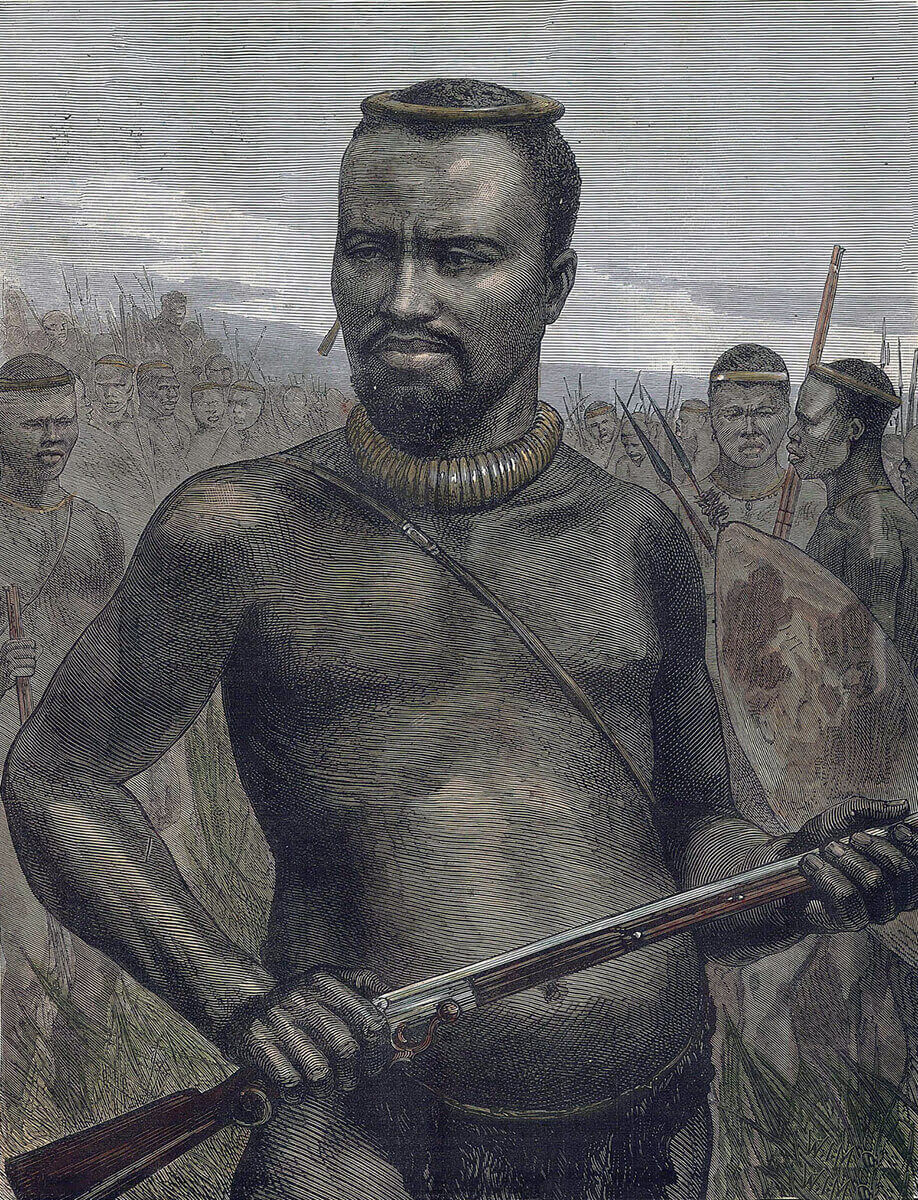

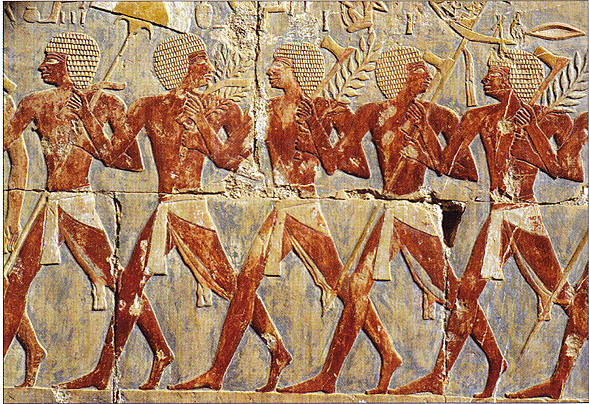




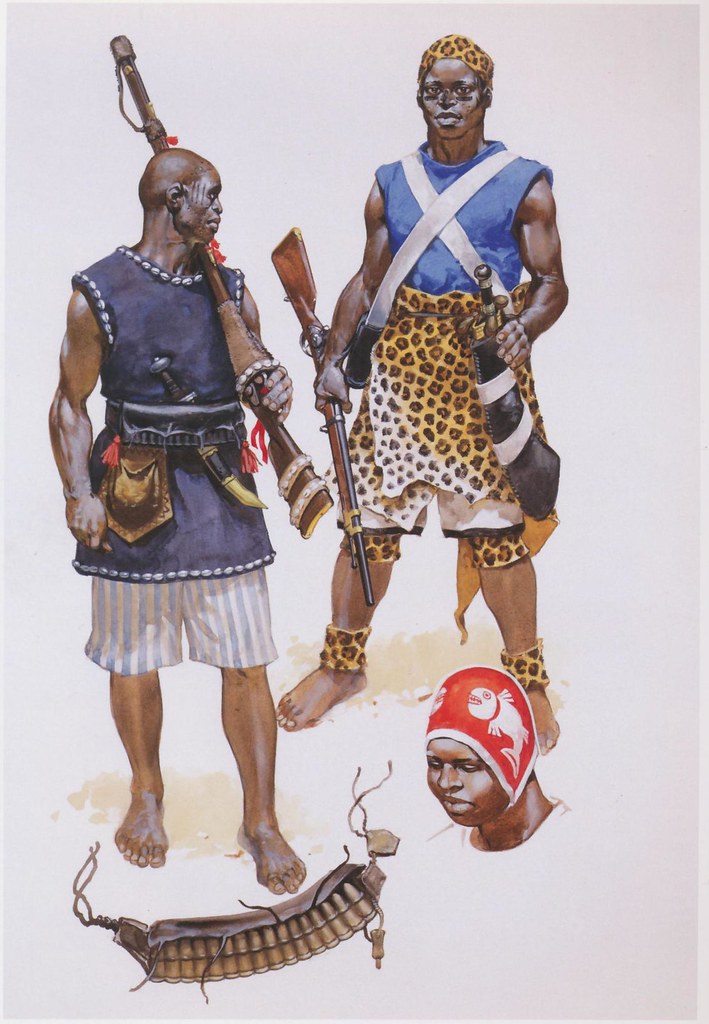
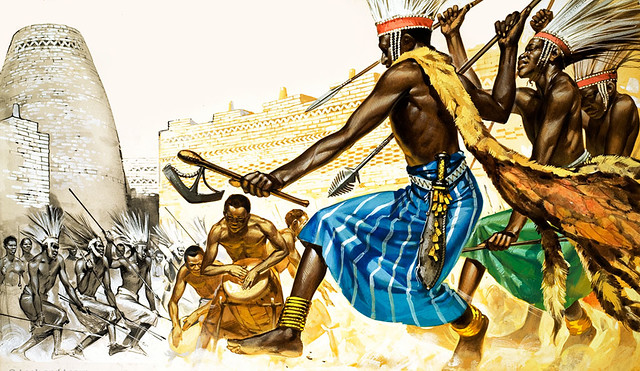



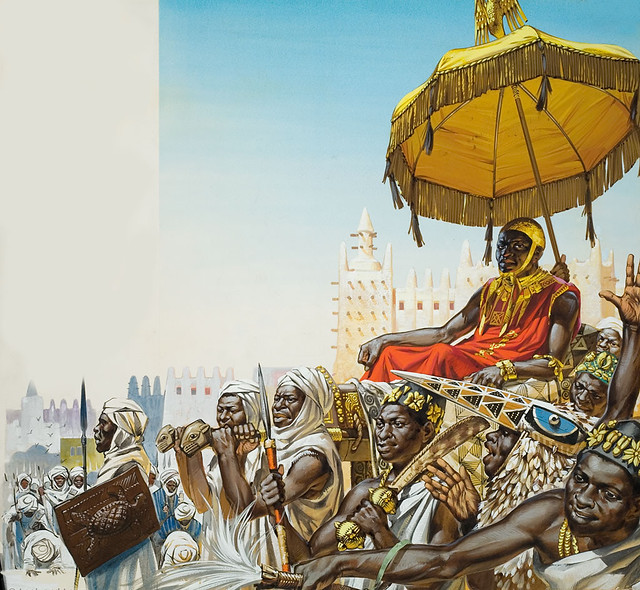

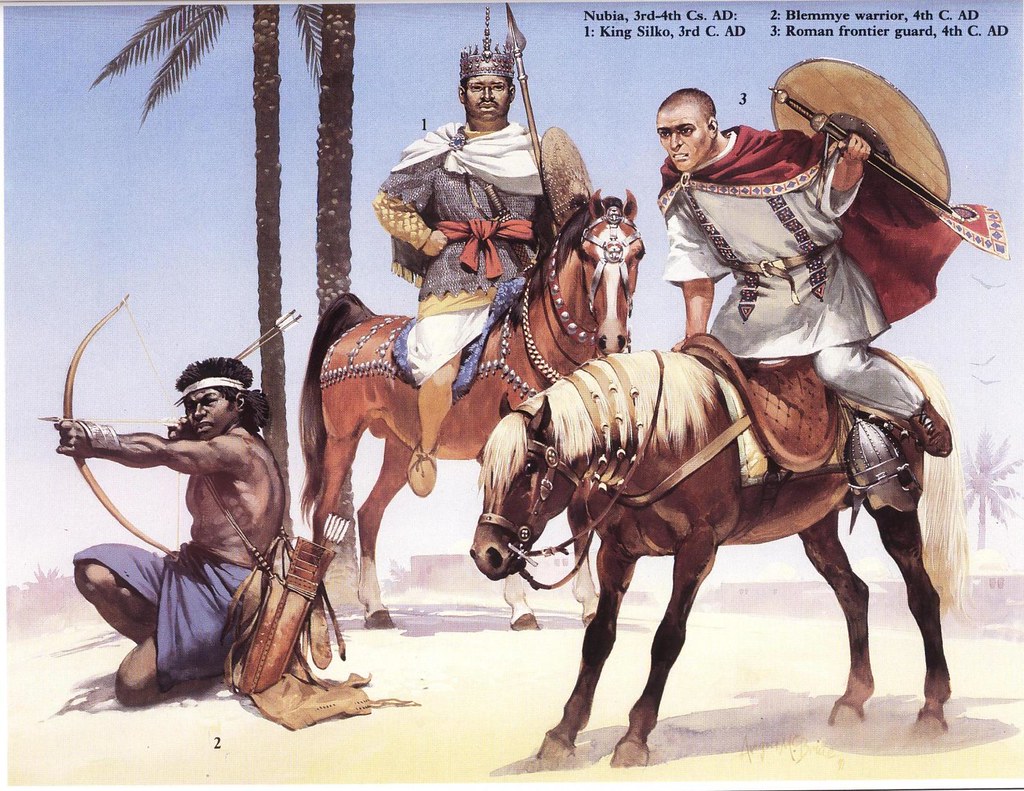

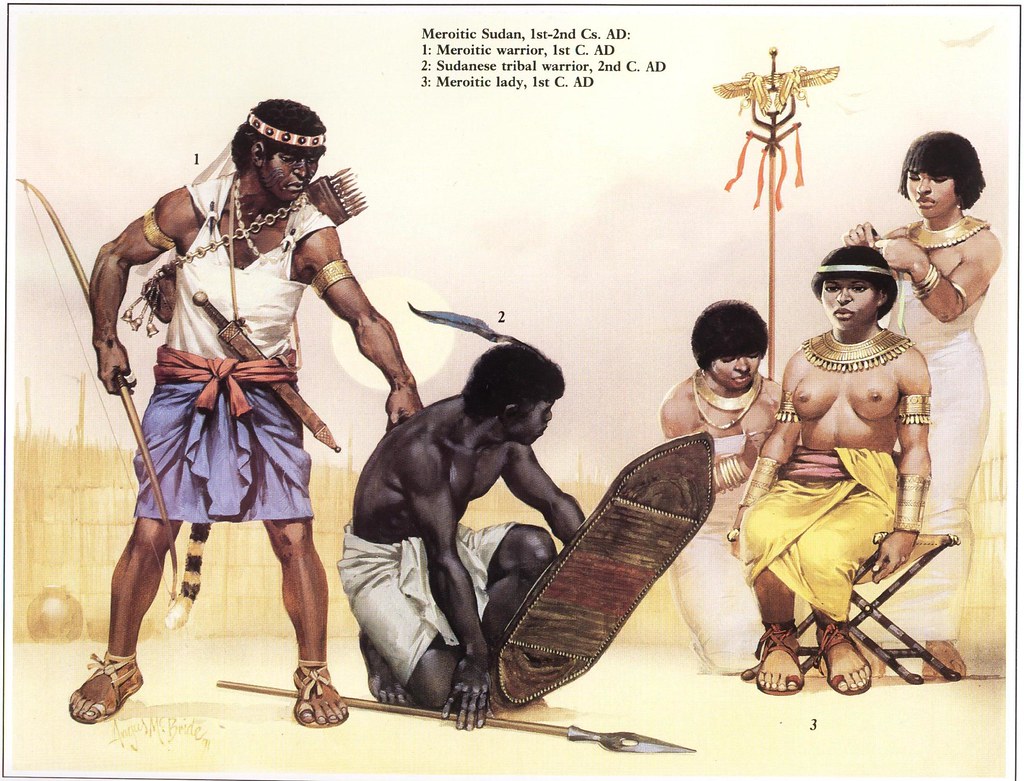

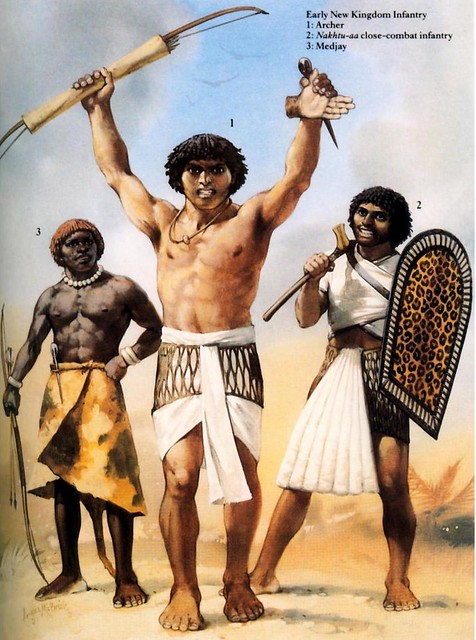
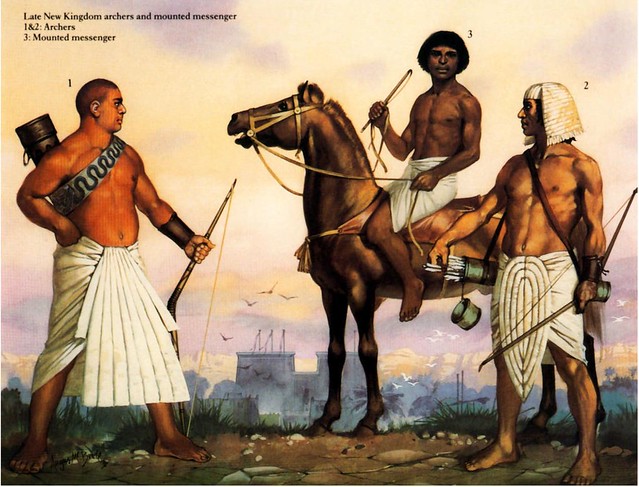


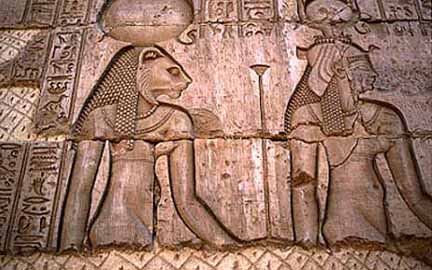

 Will post more soon...
Will post more soon...